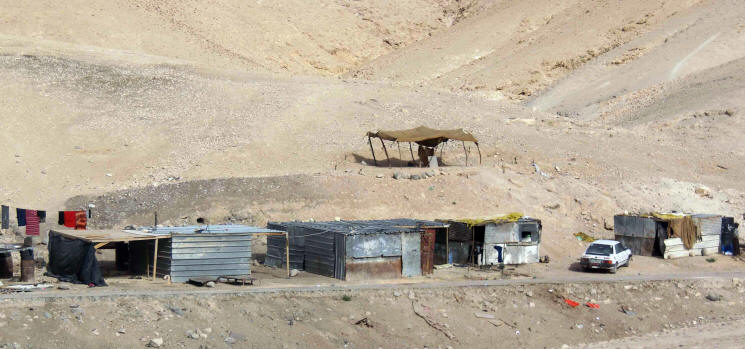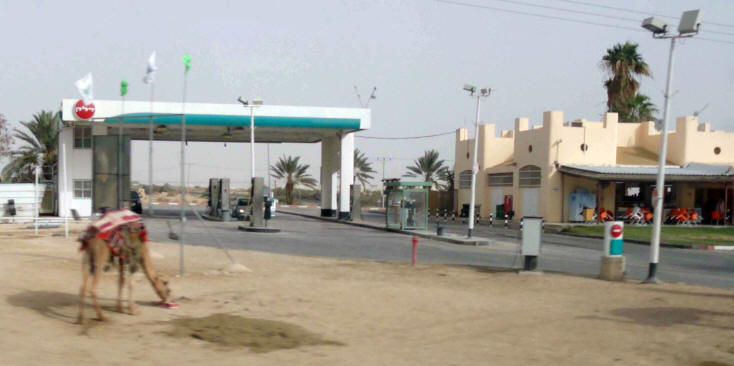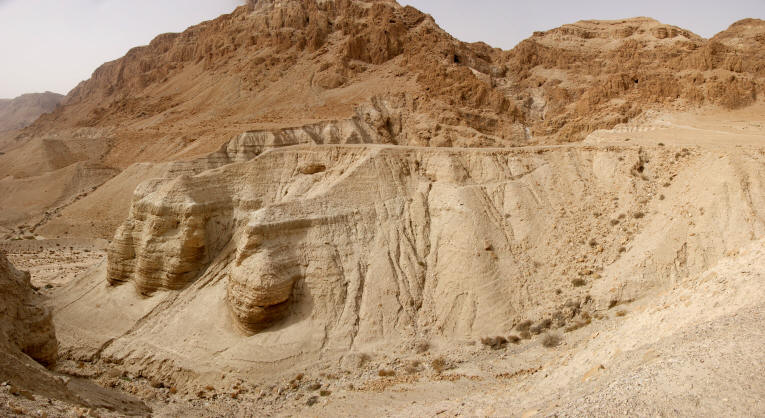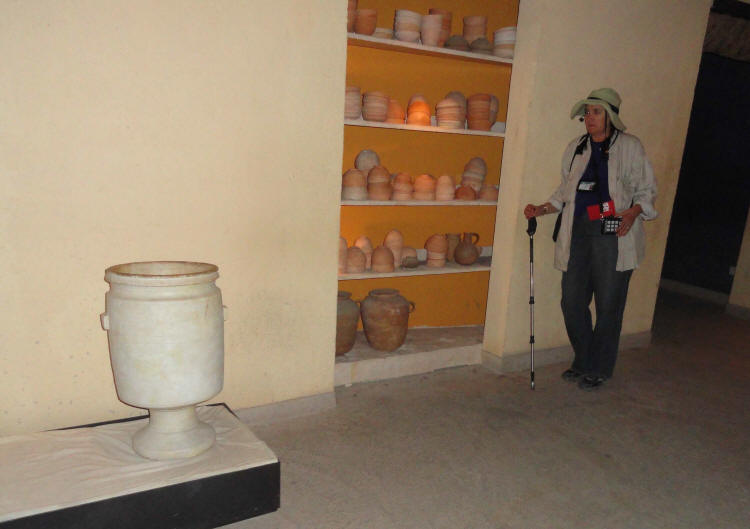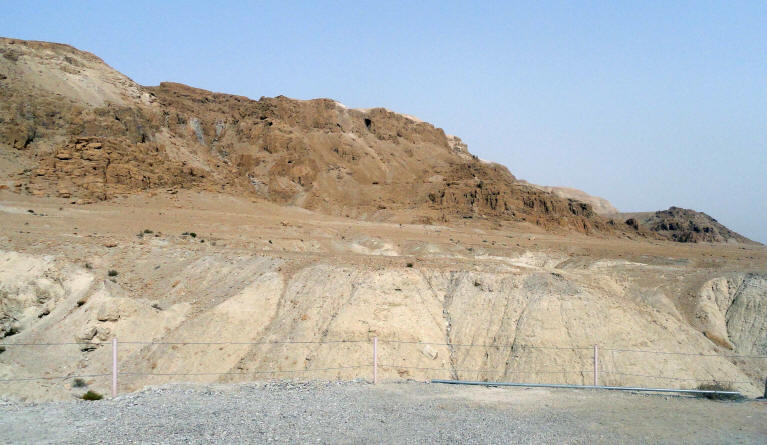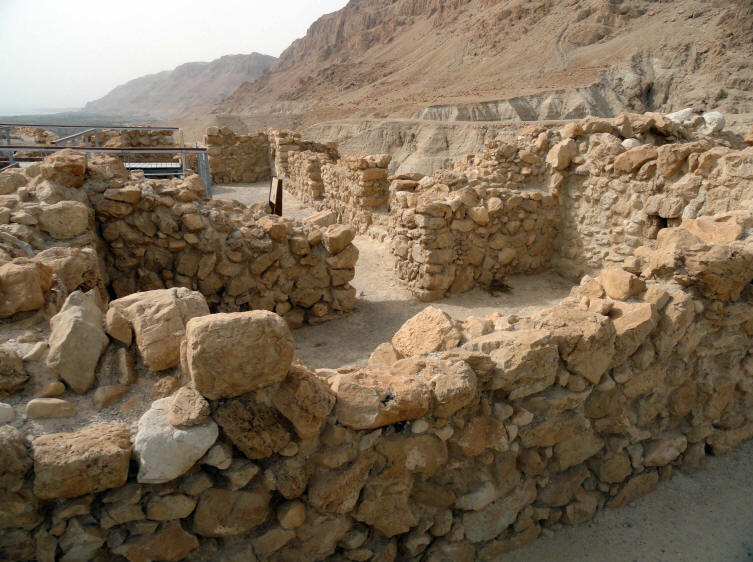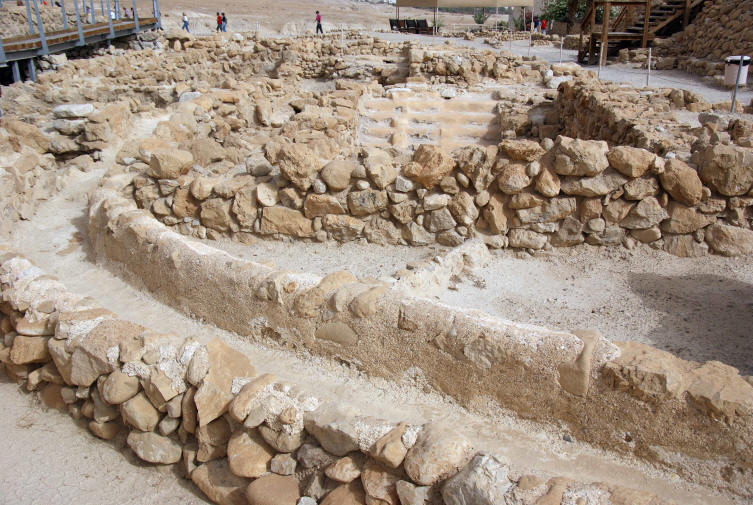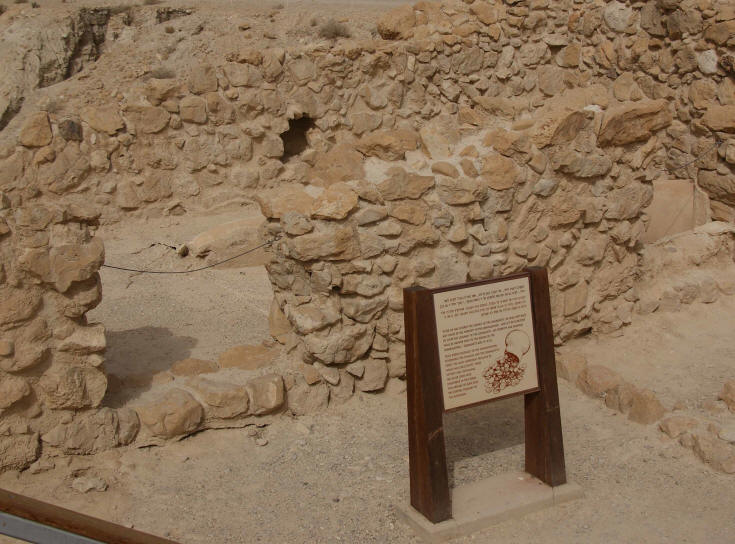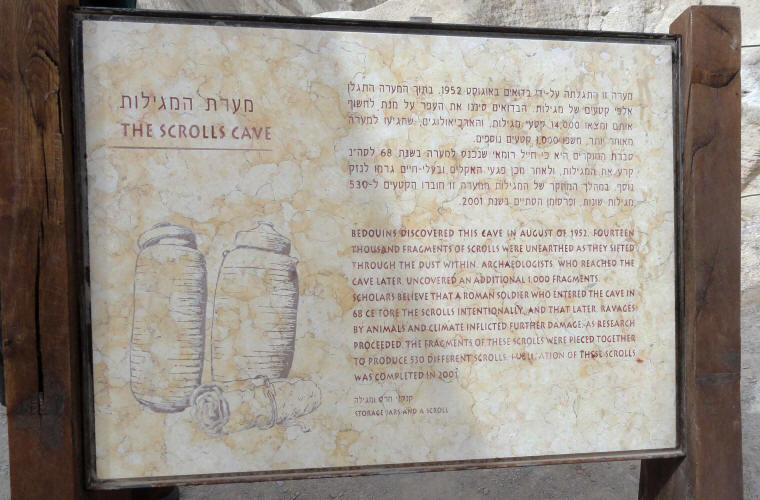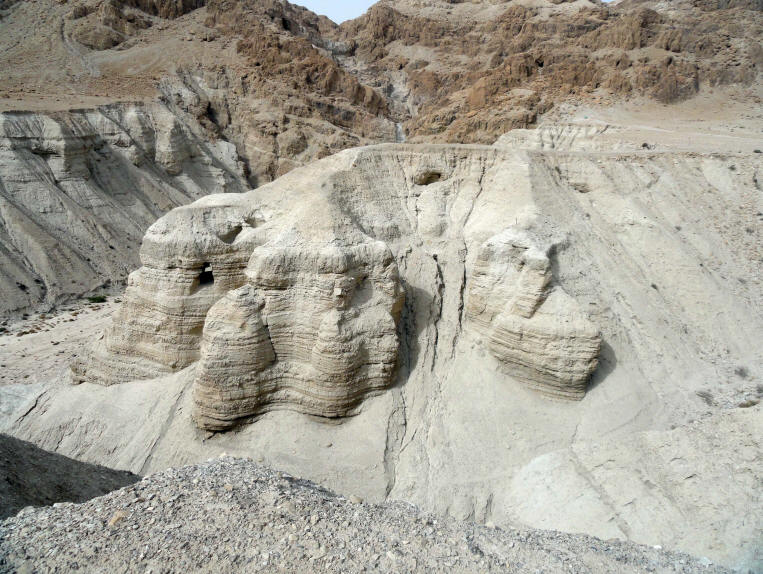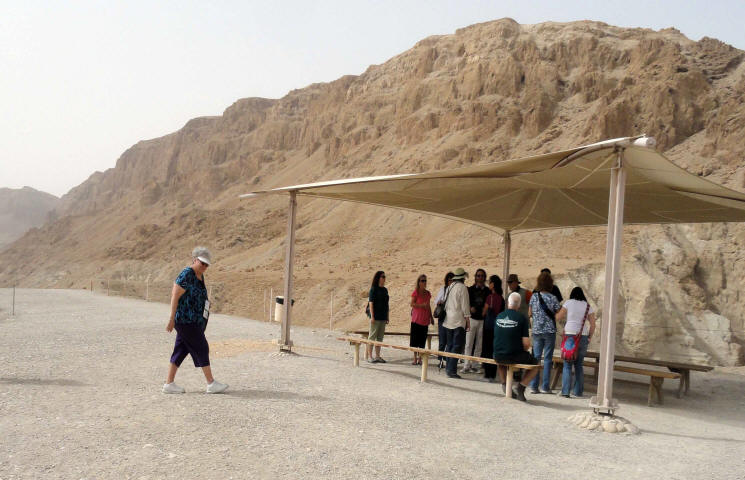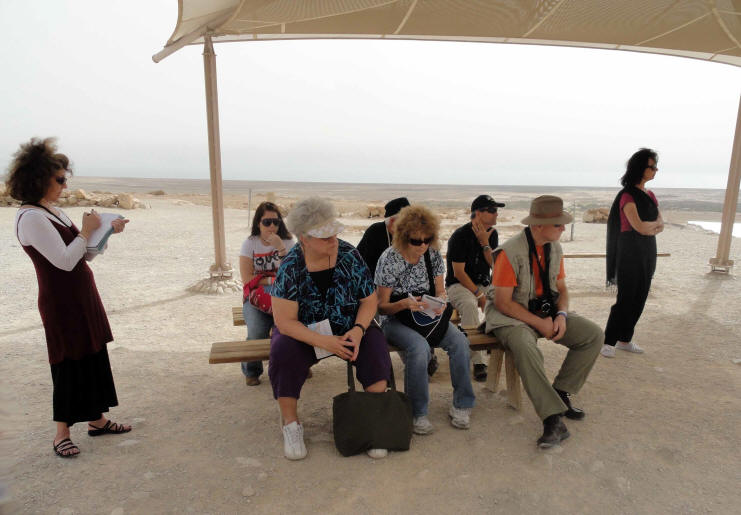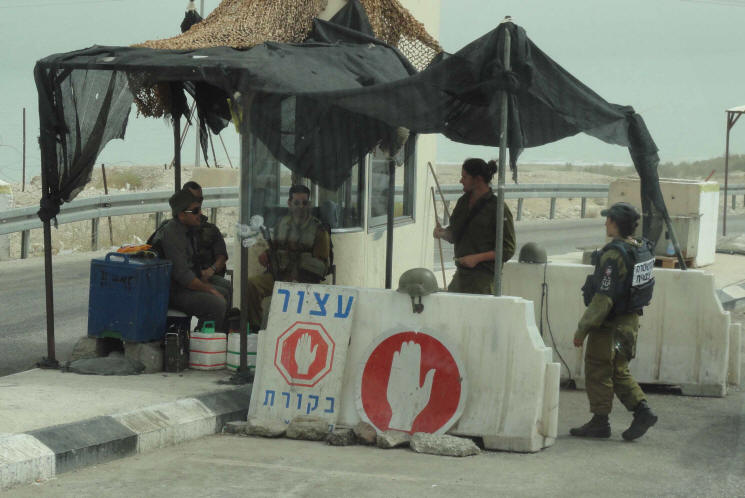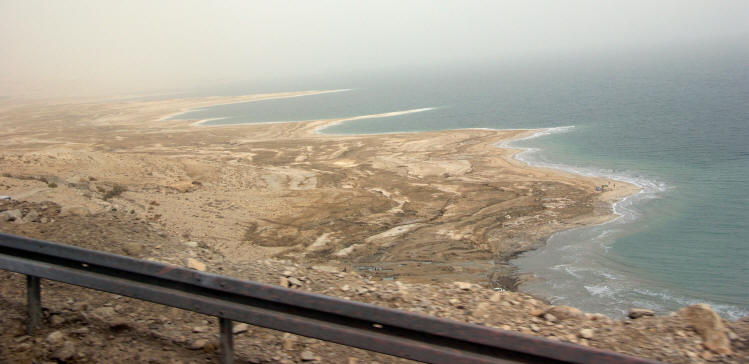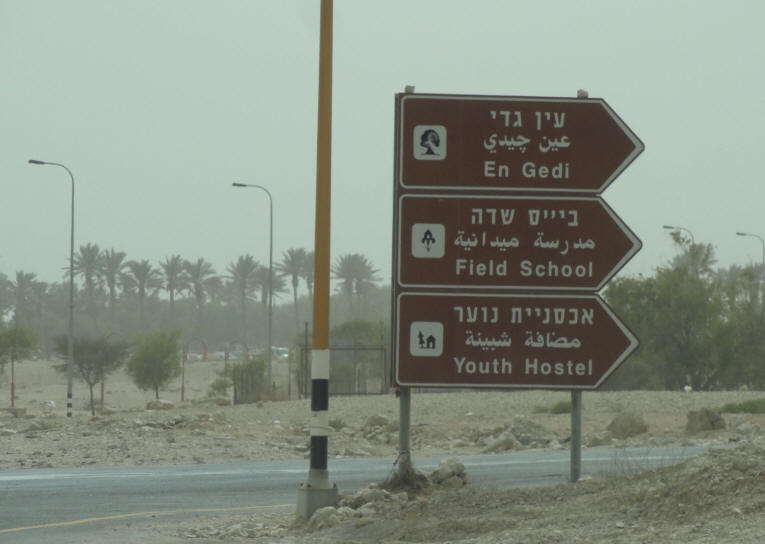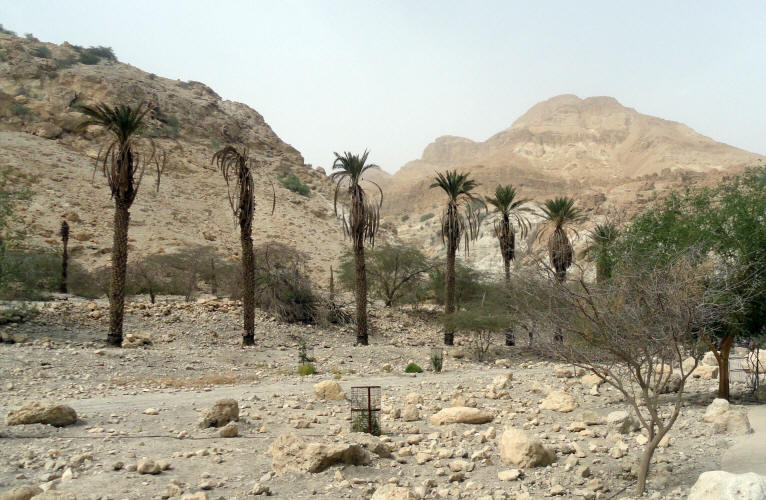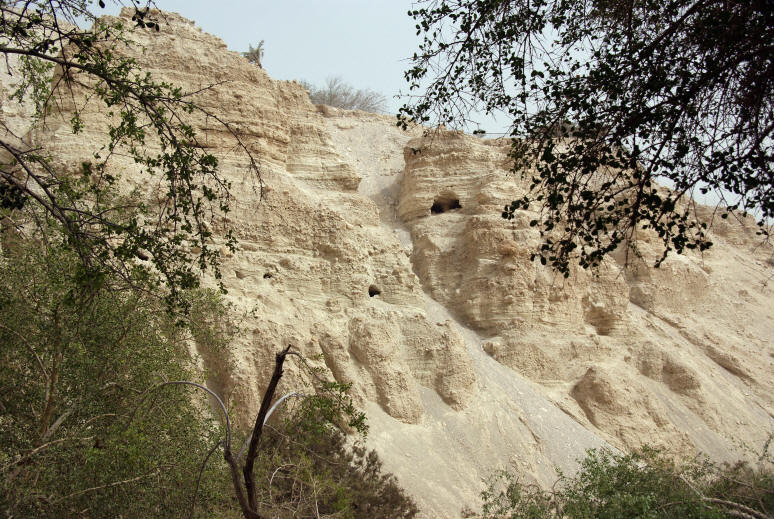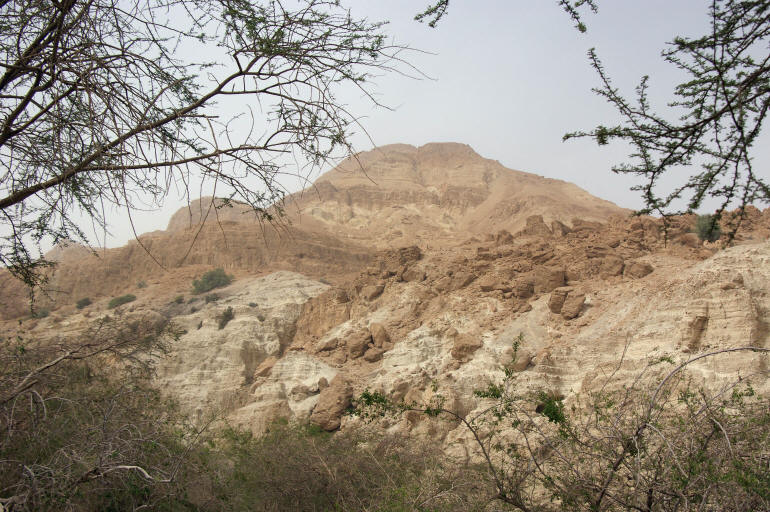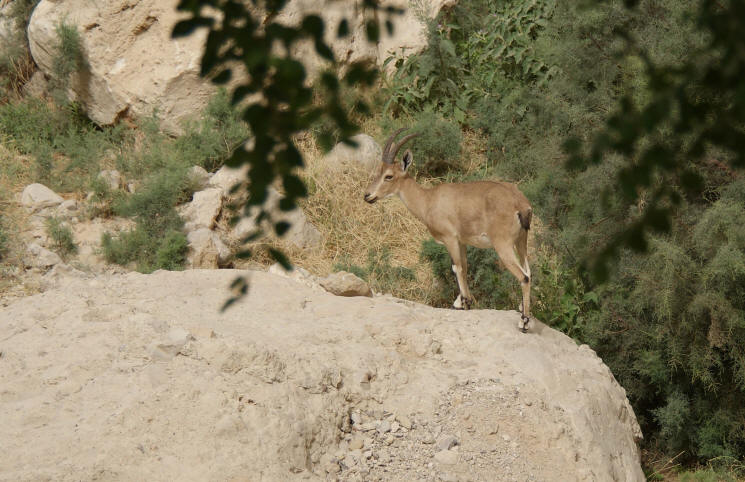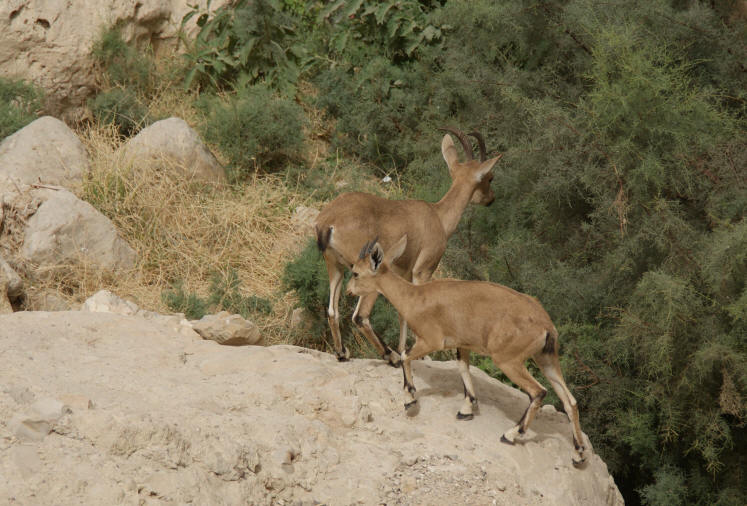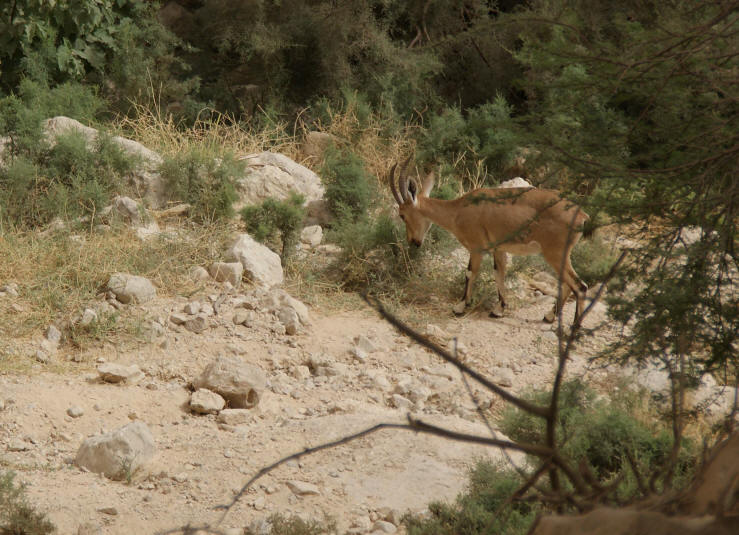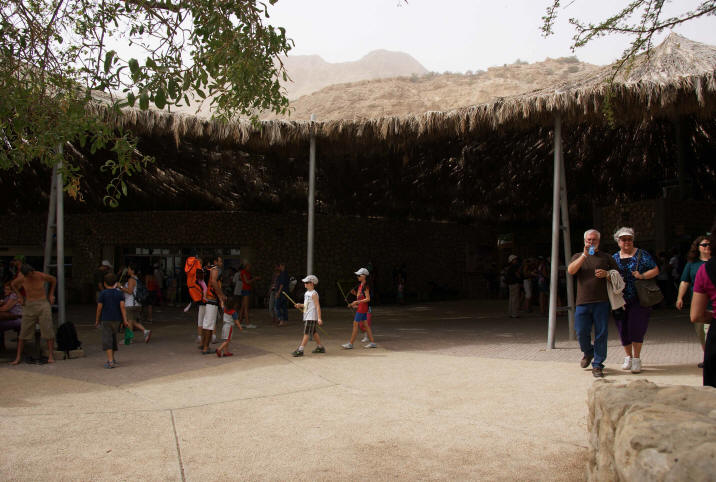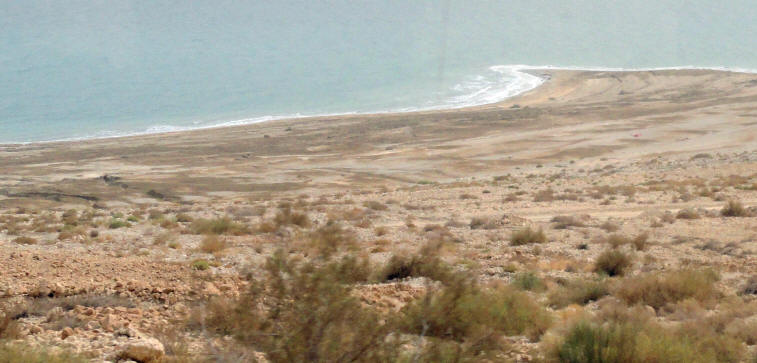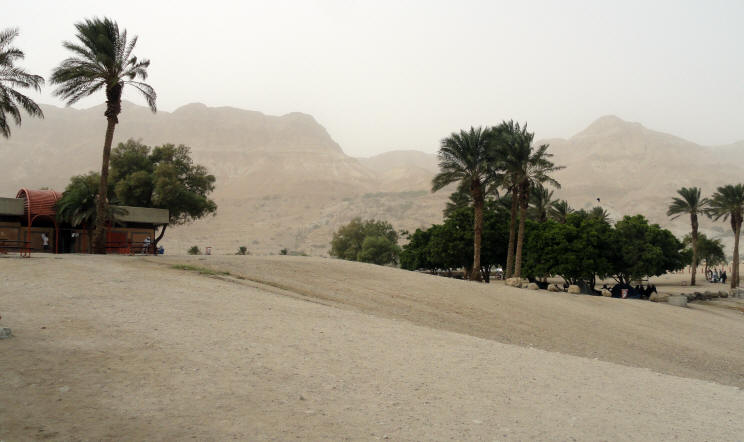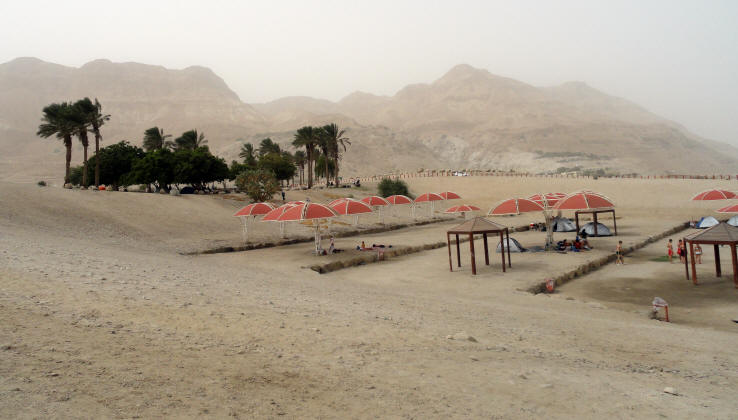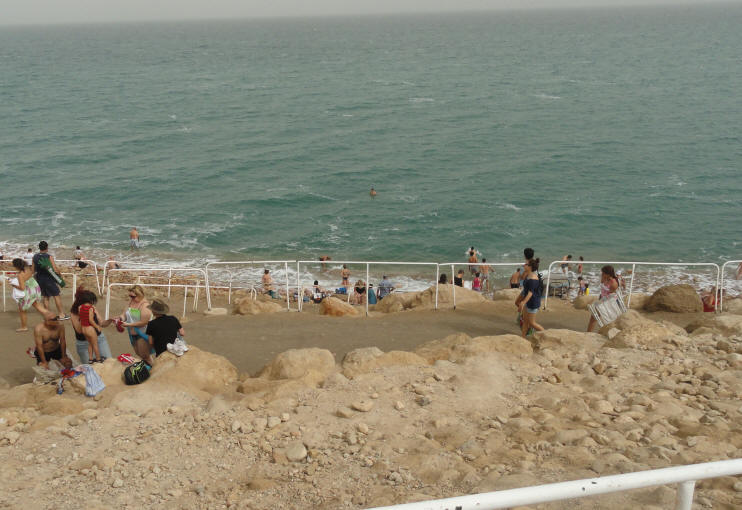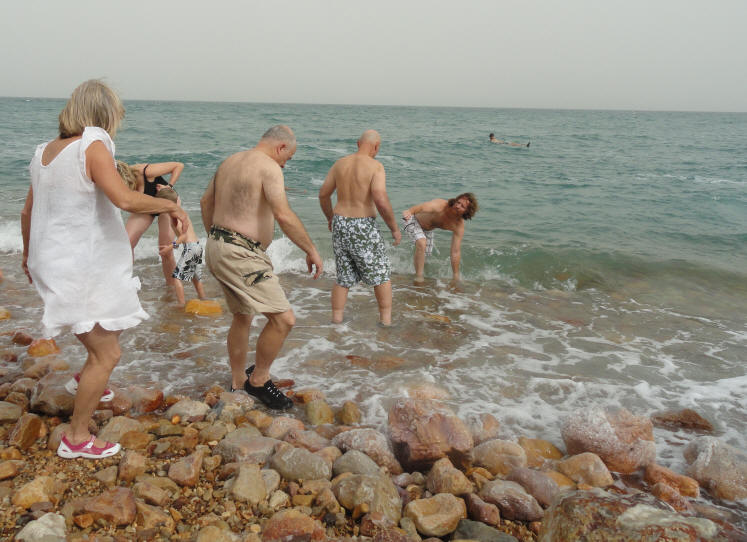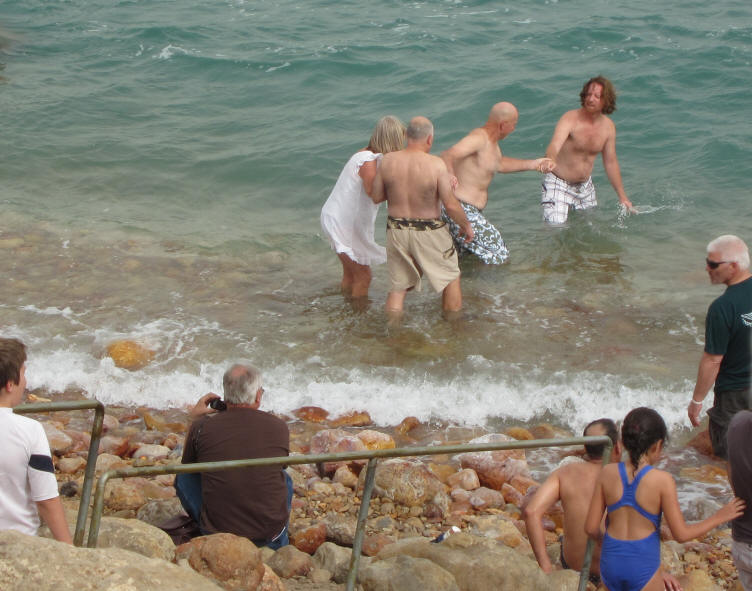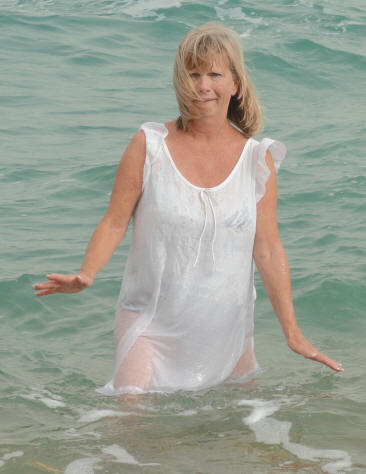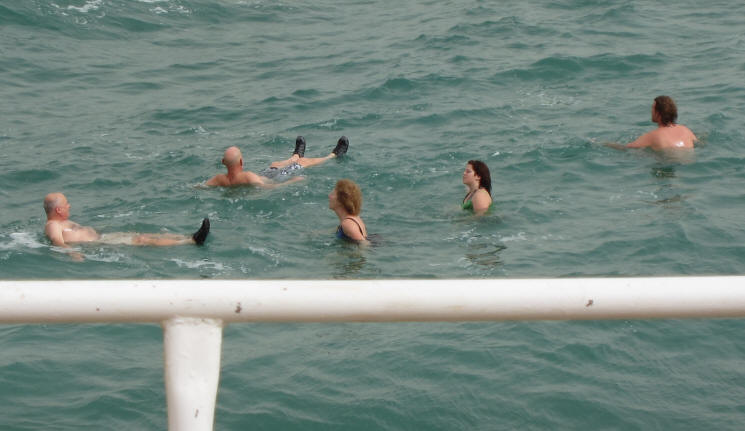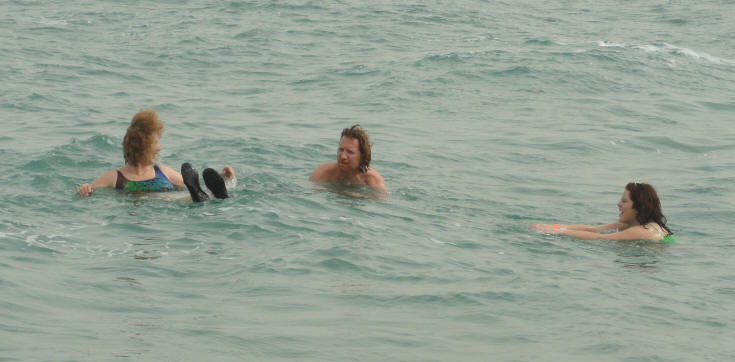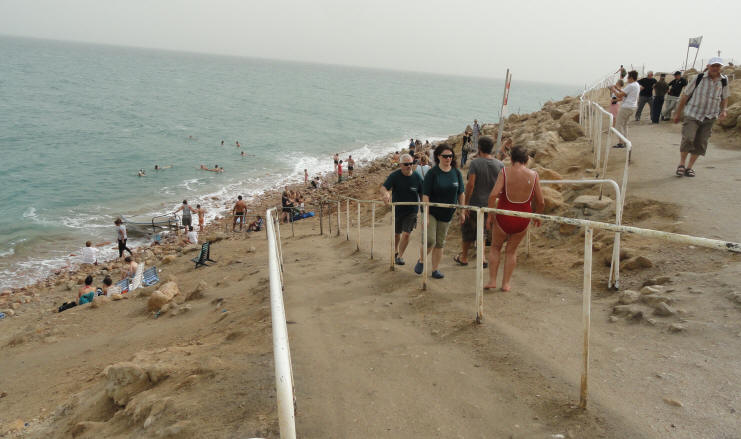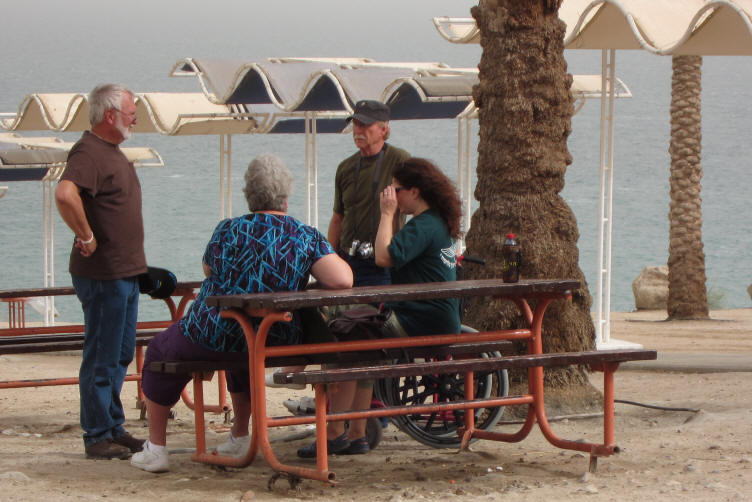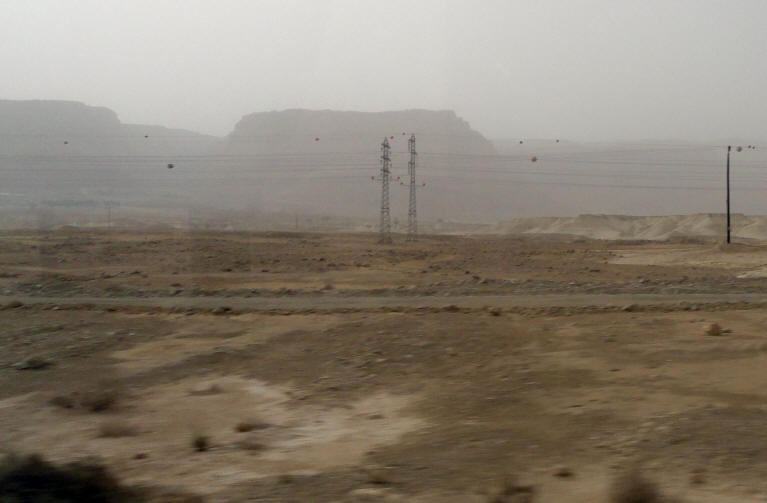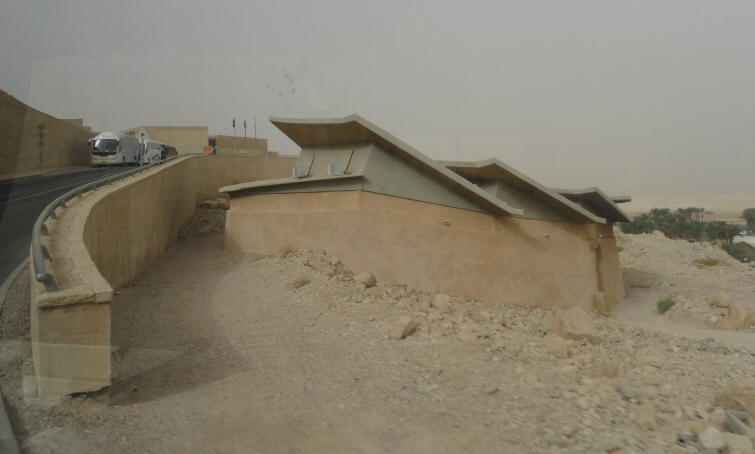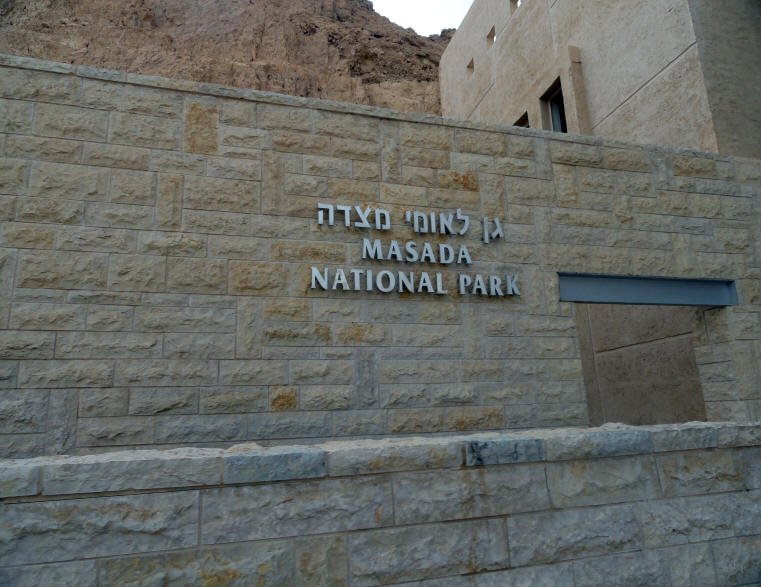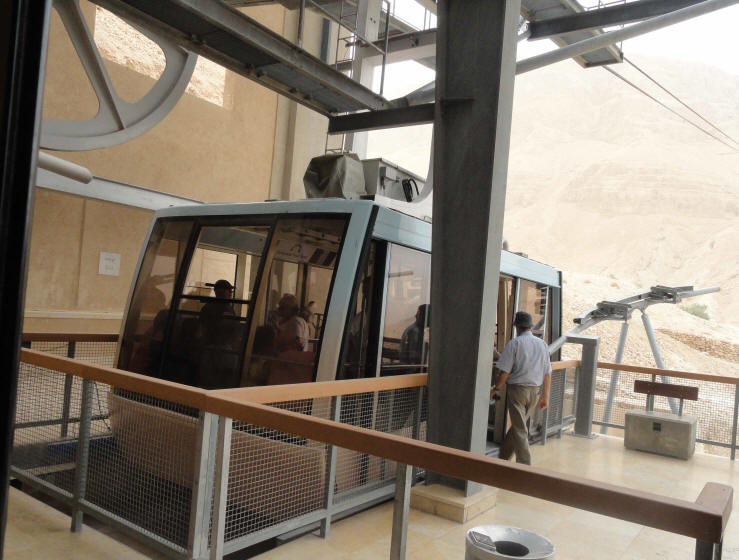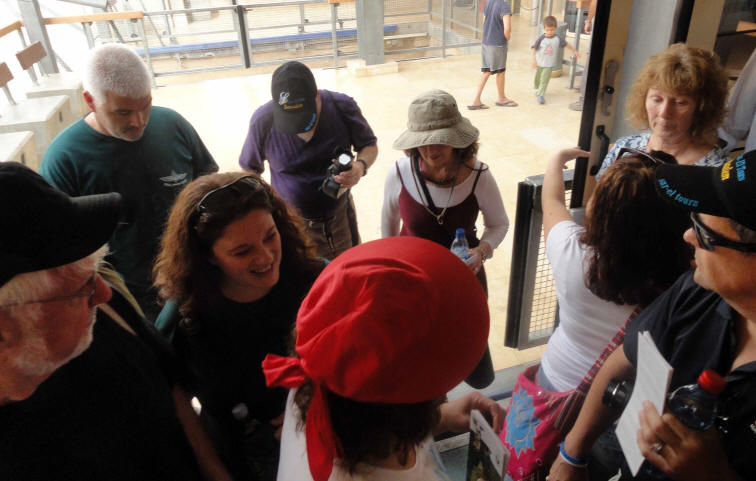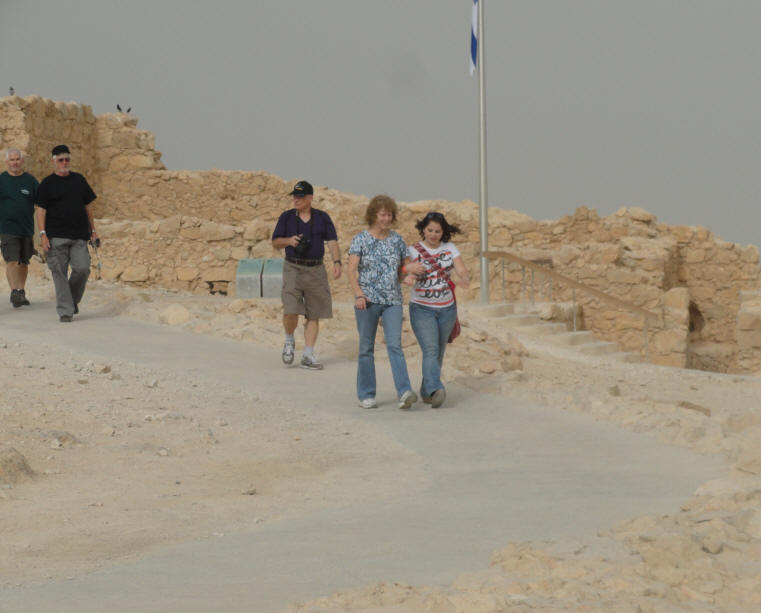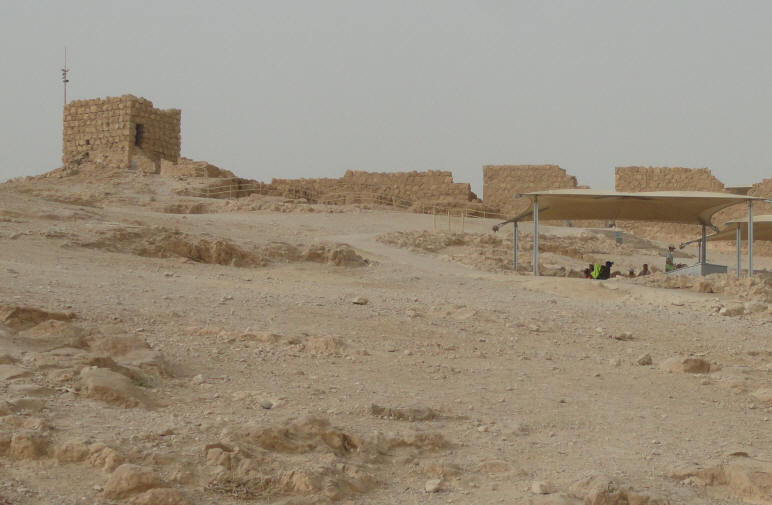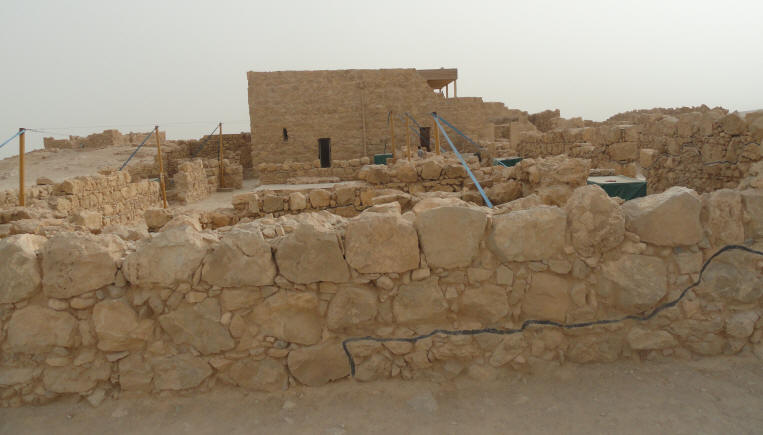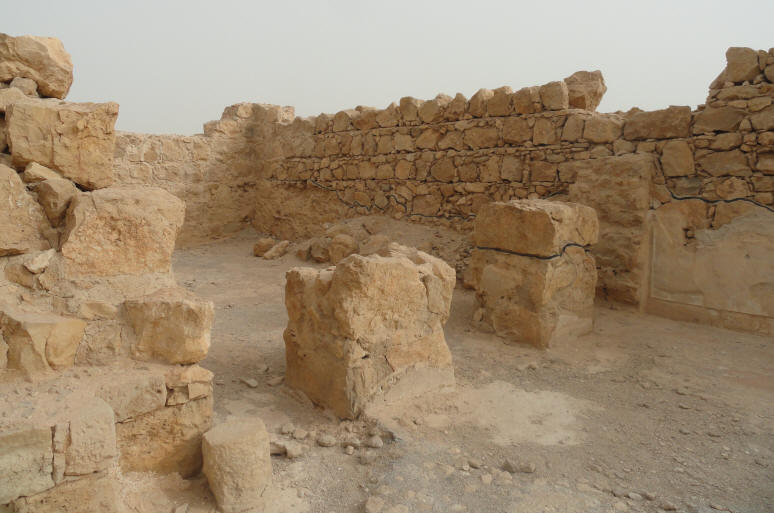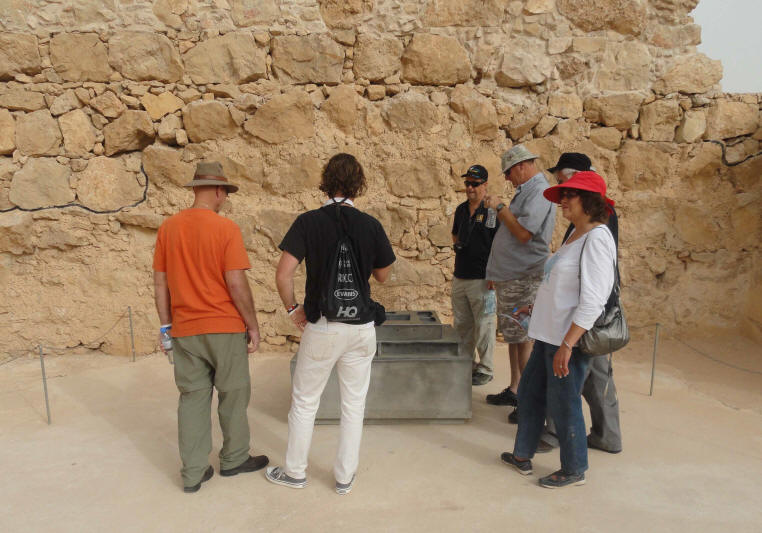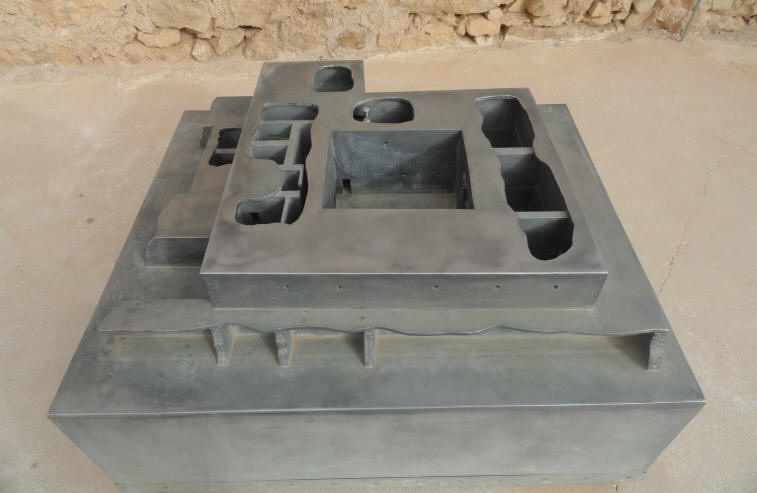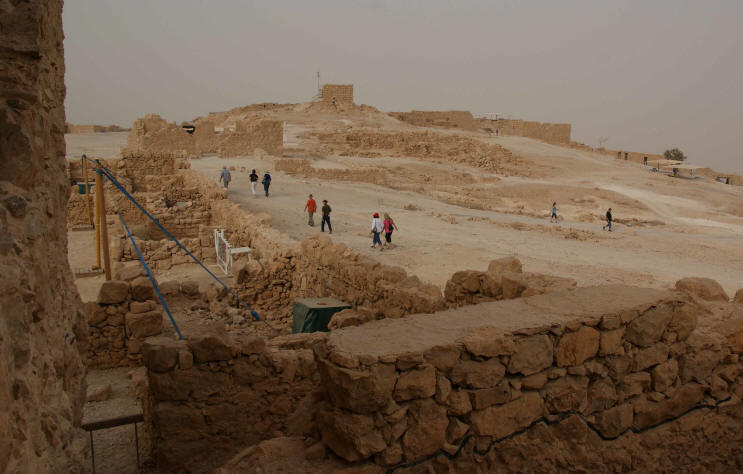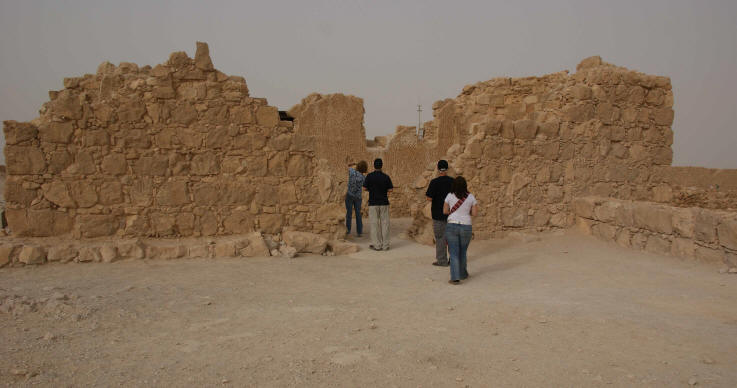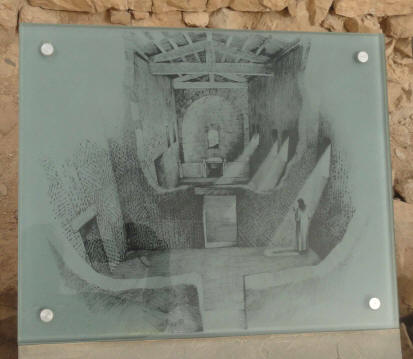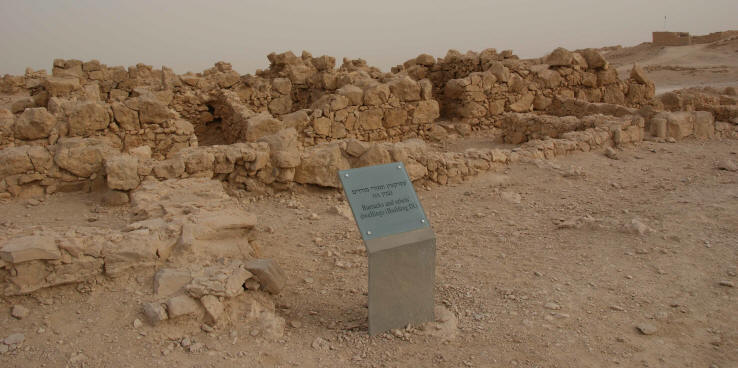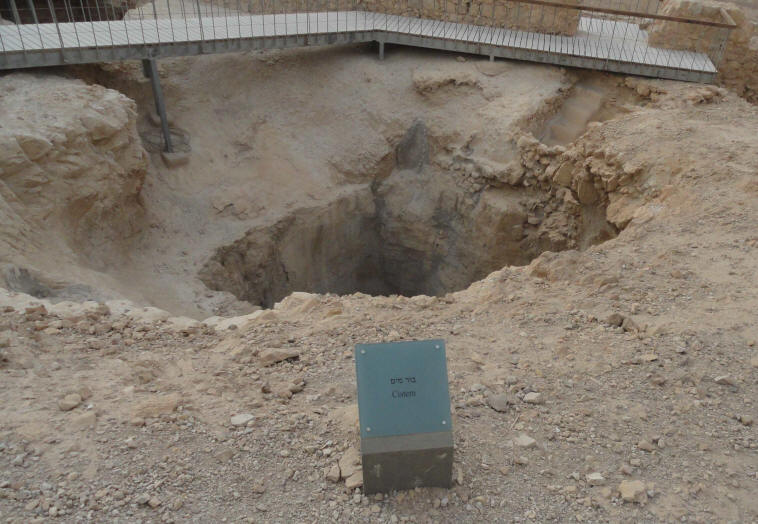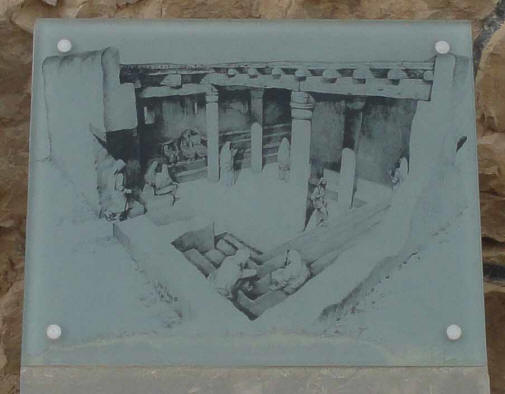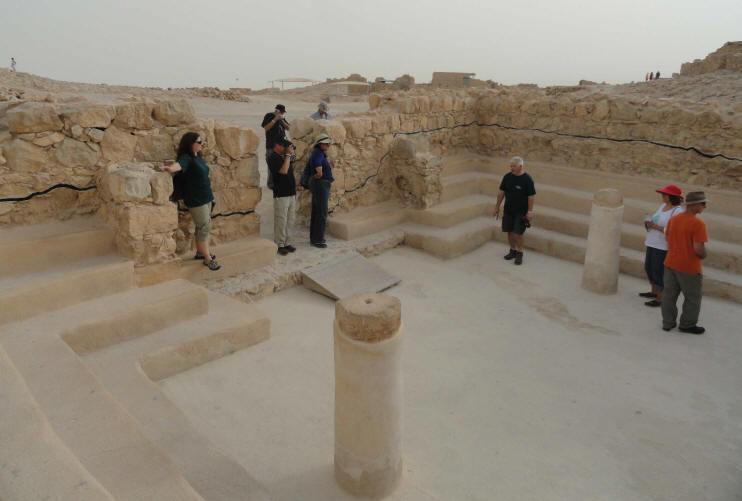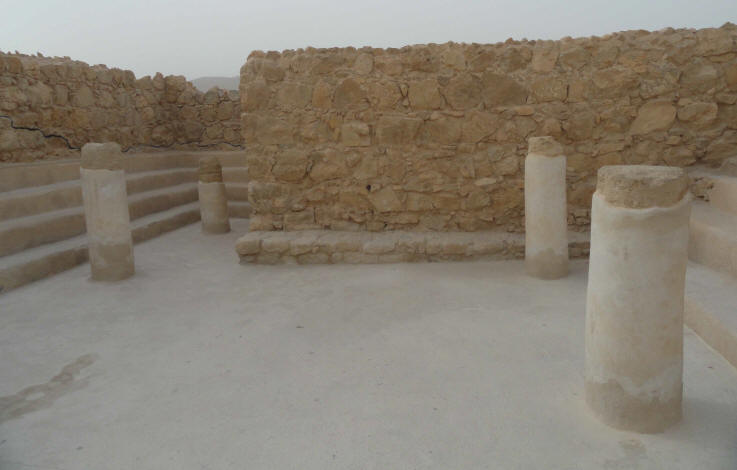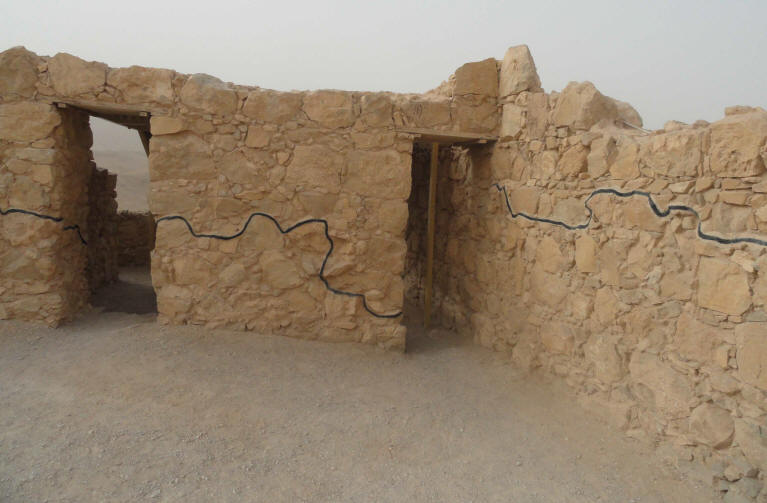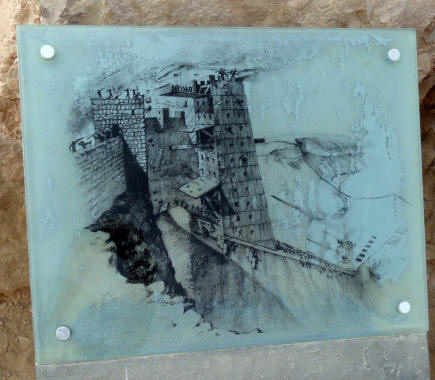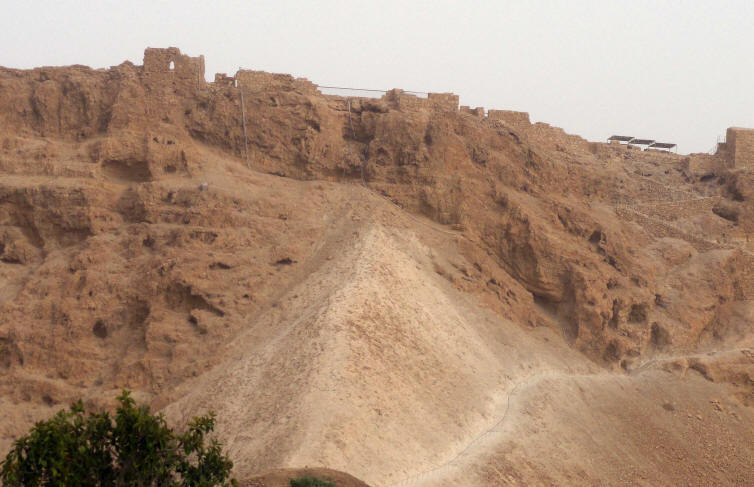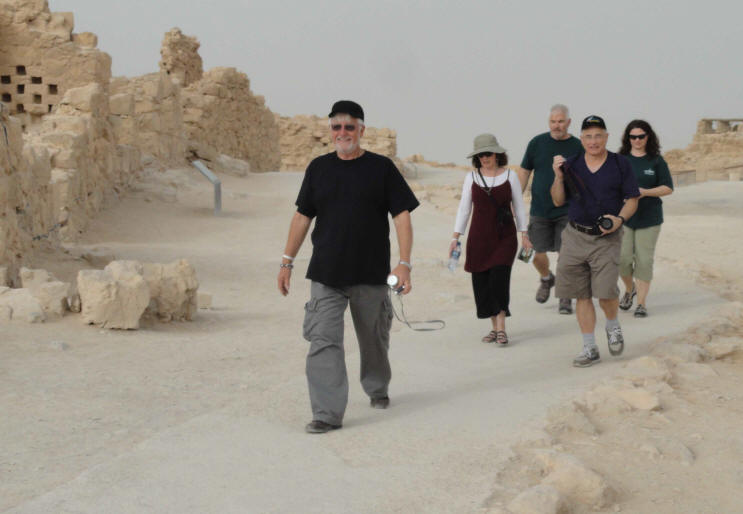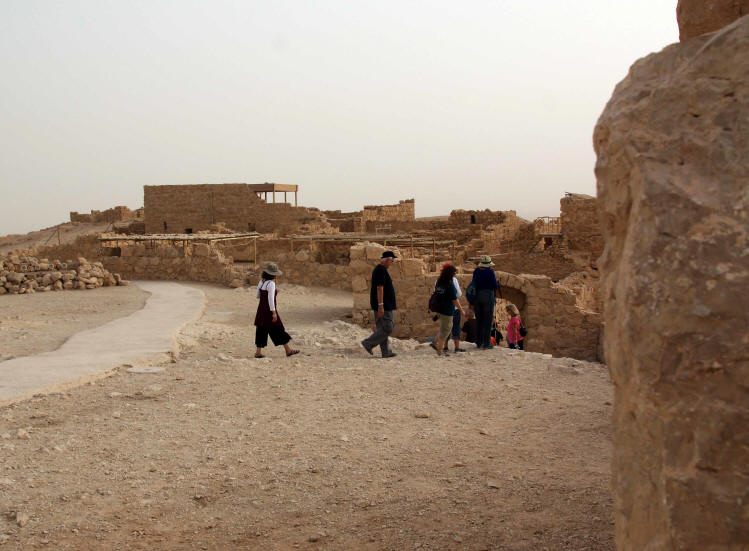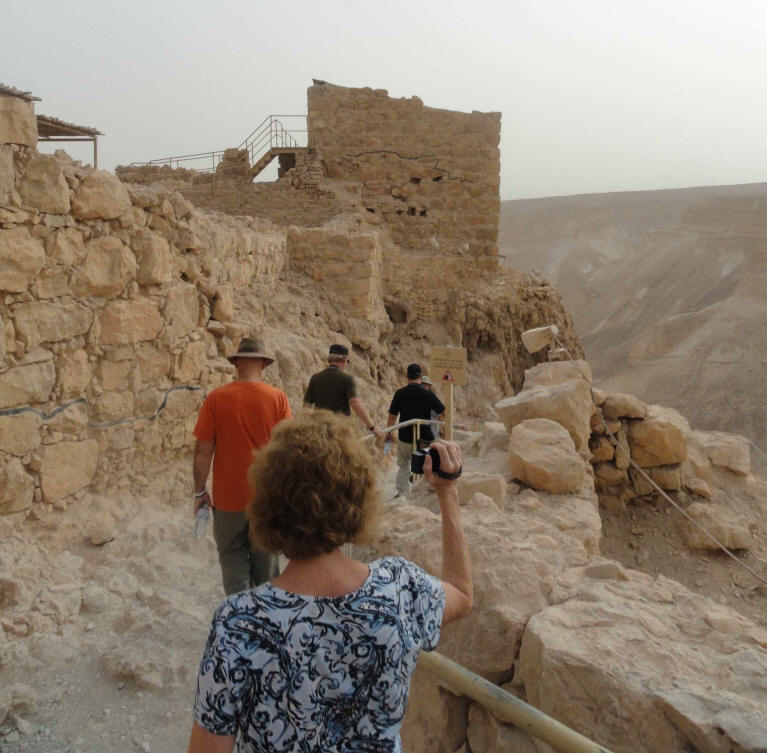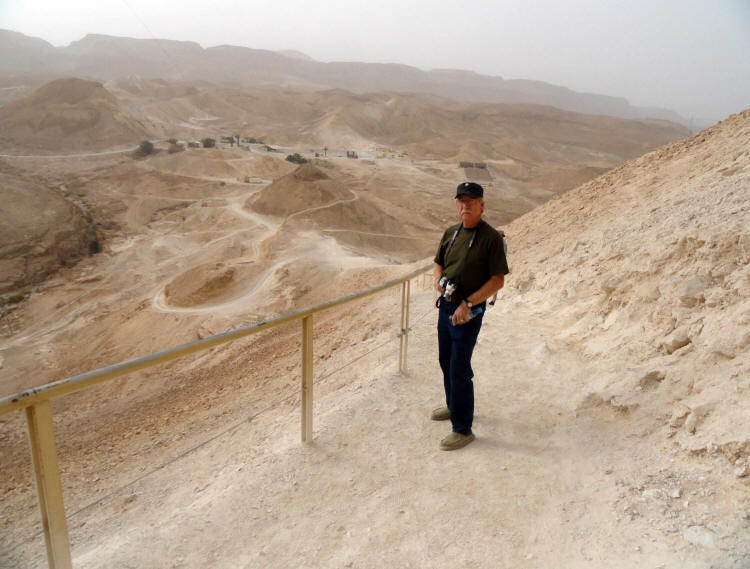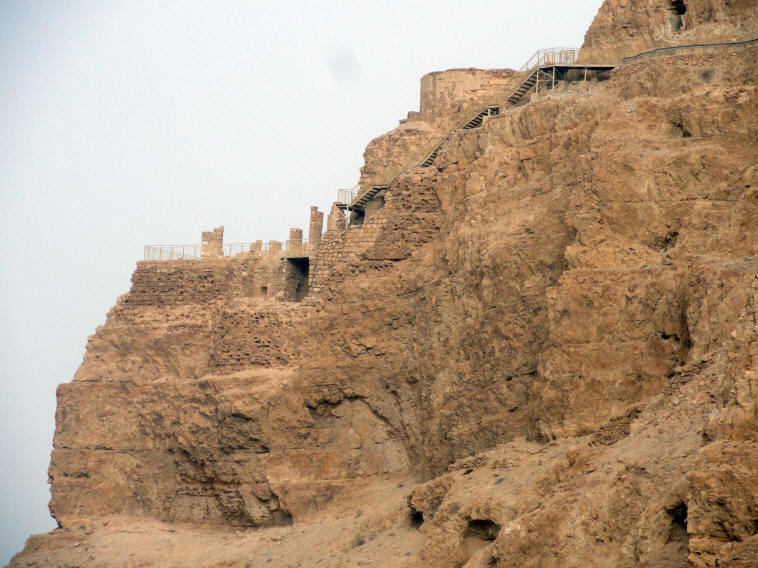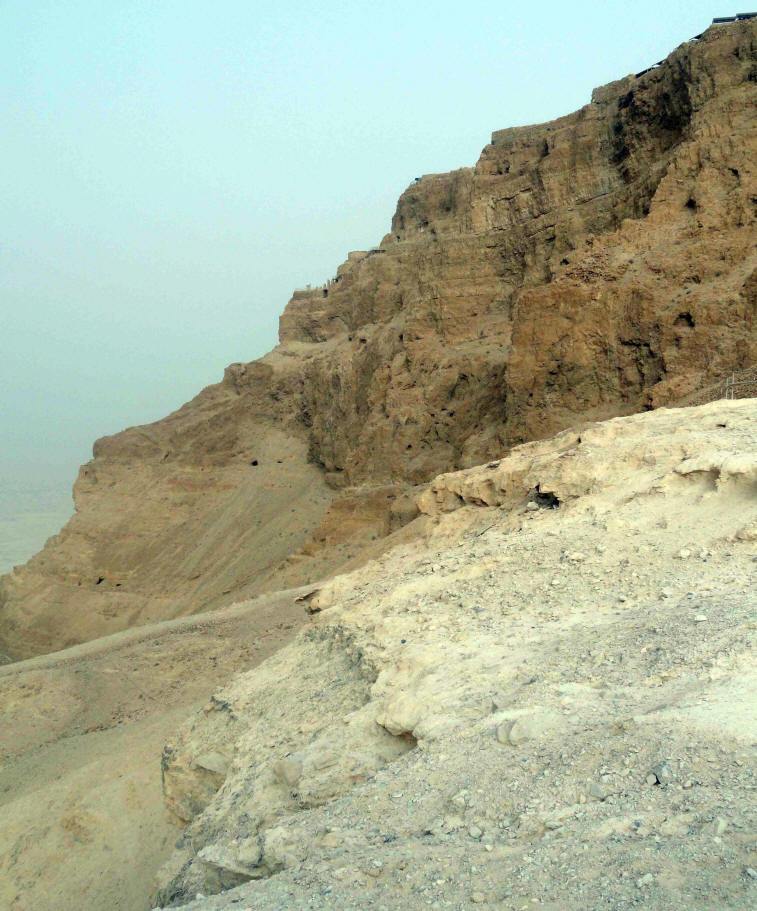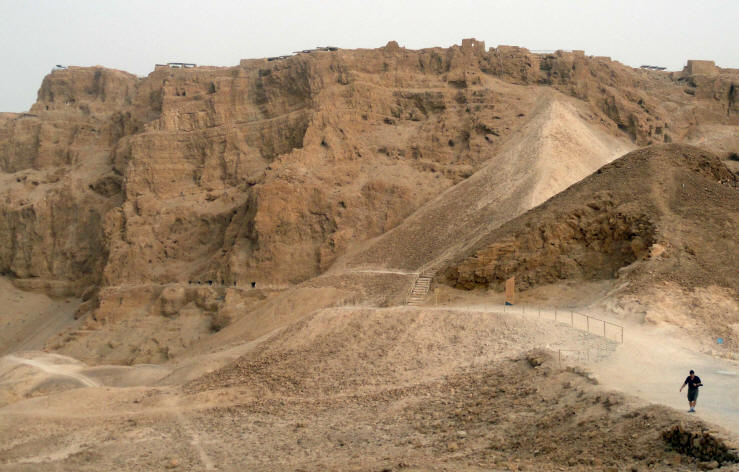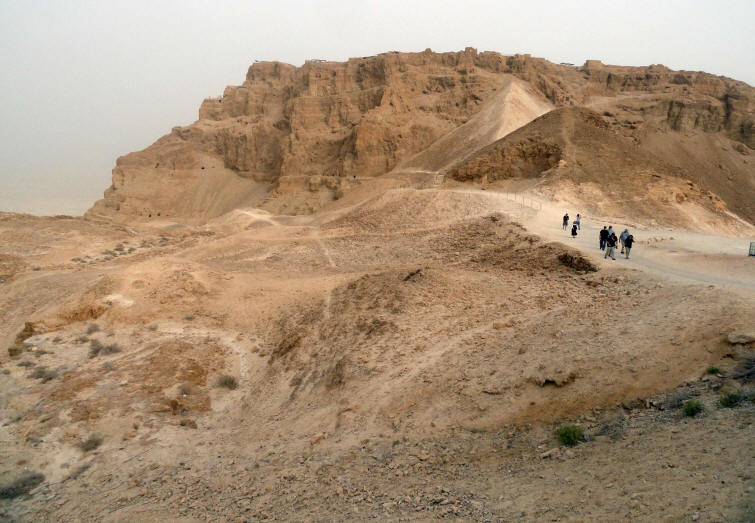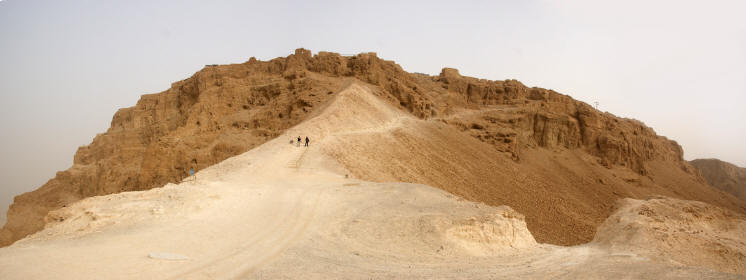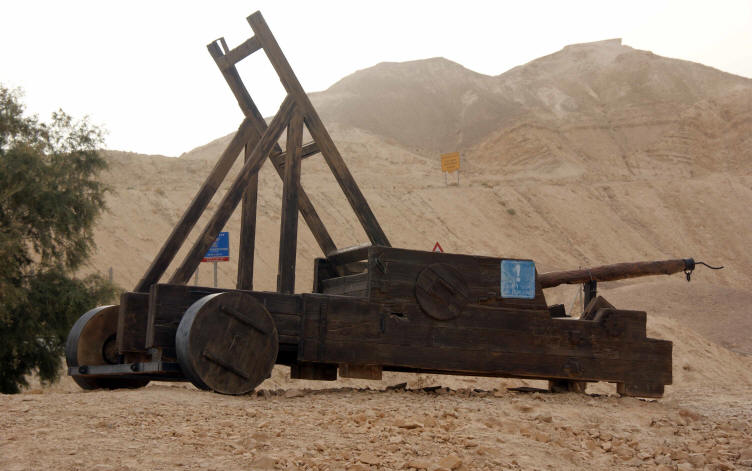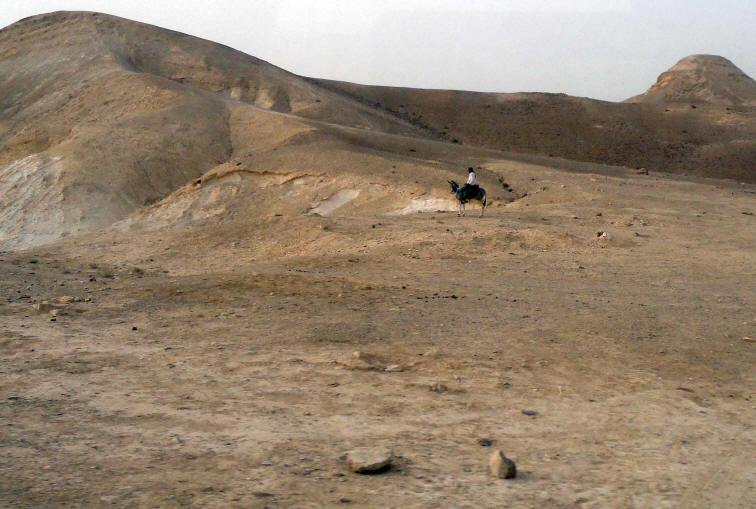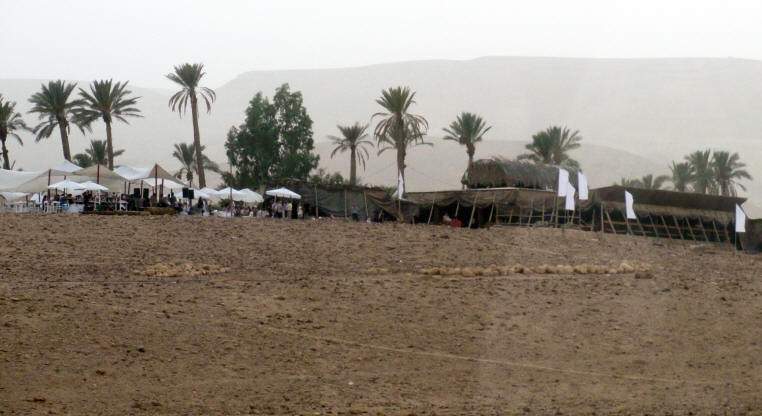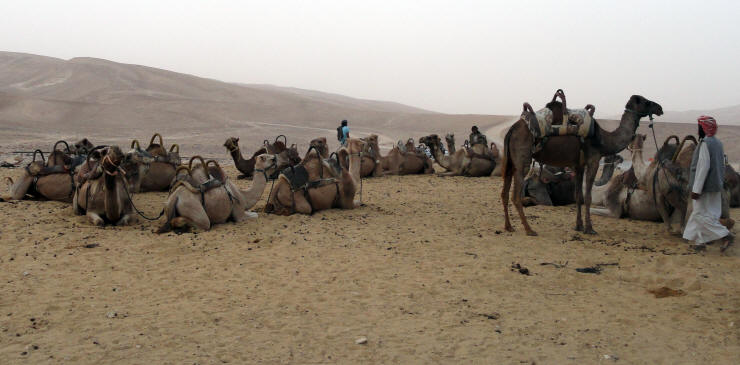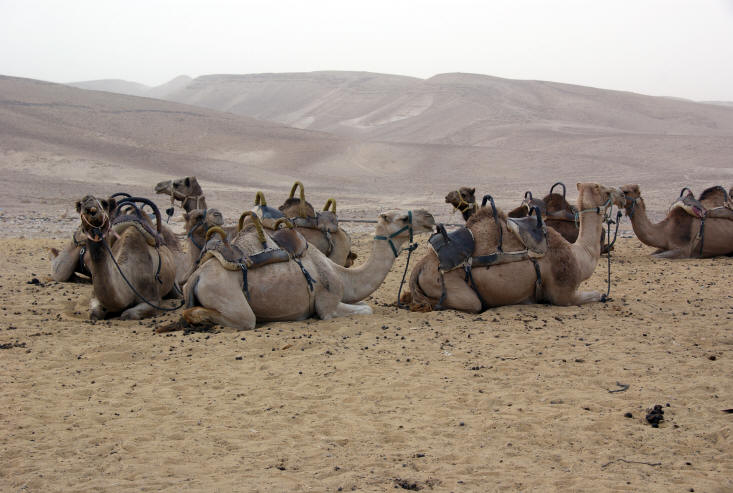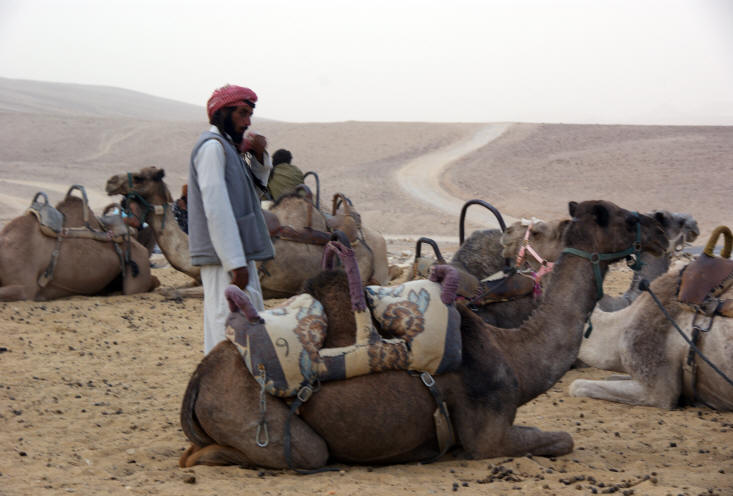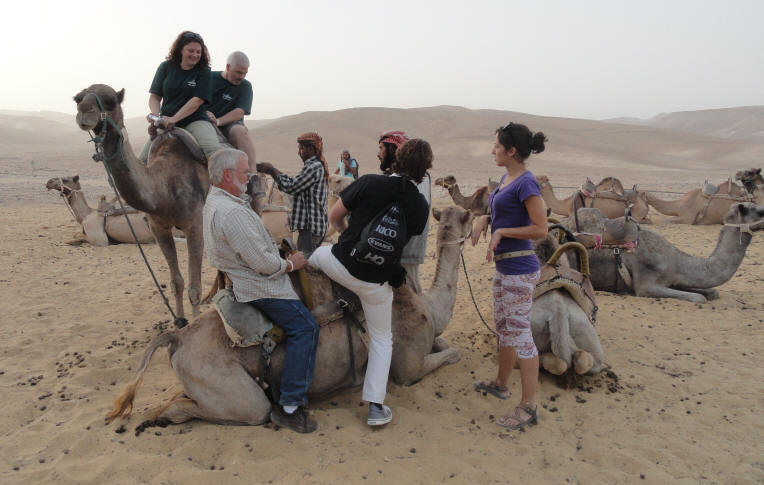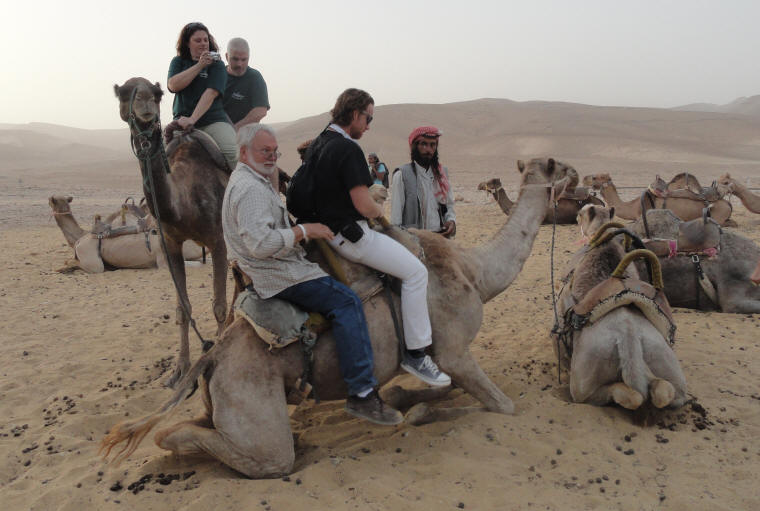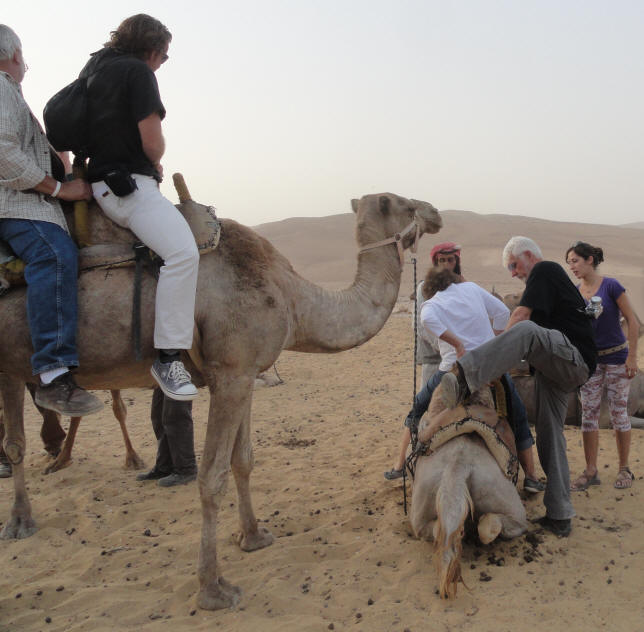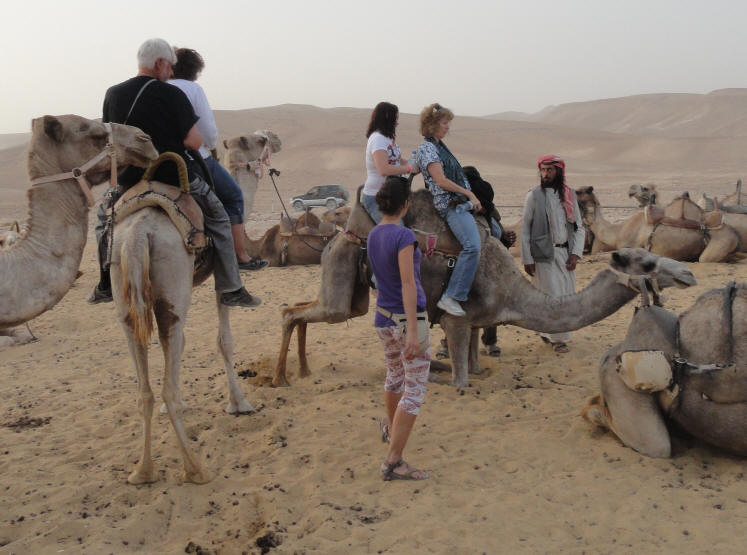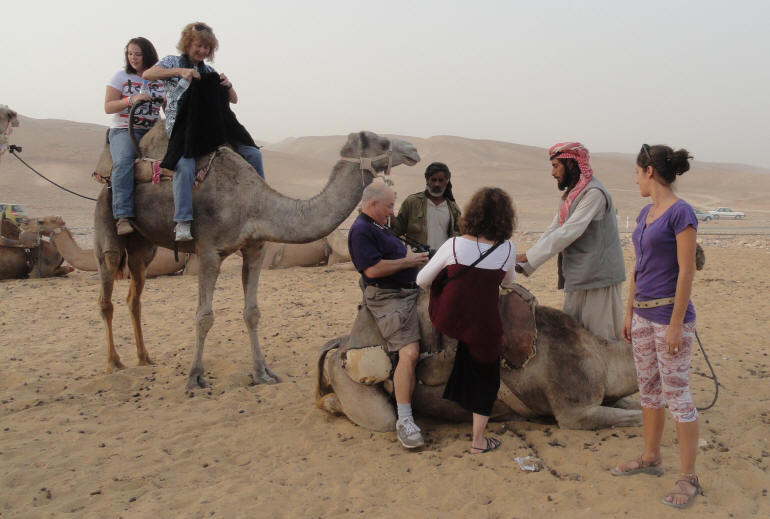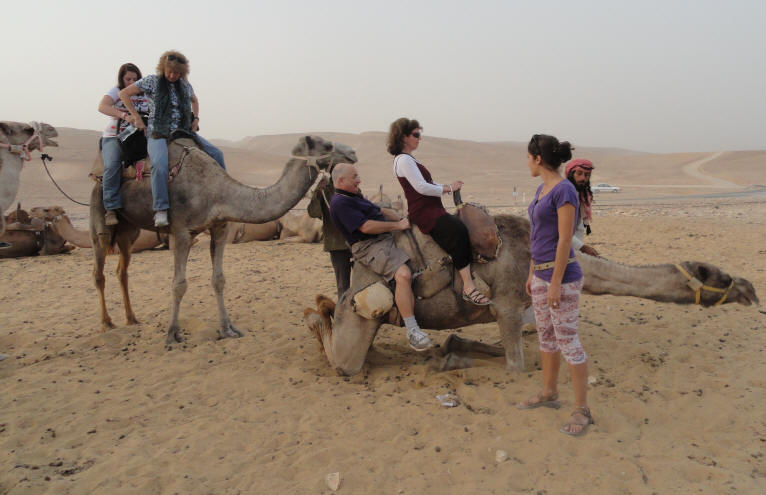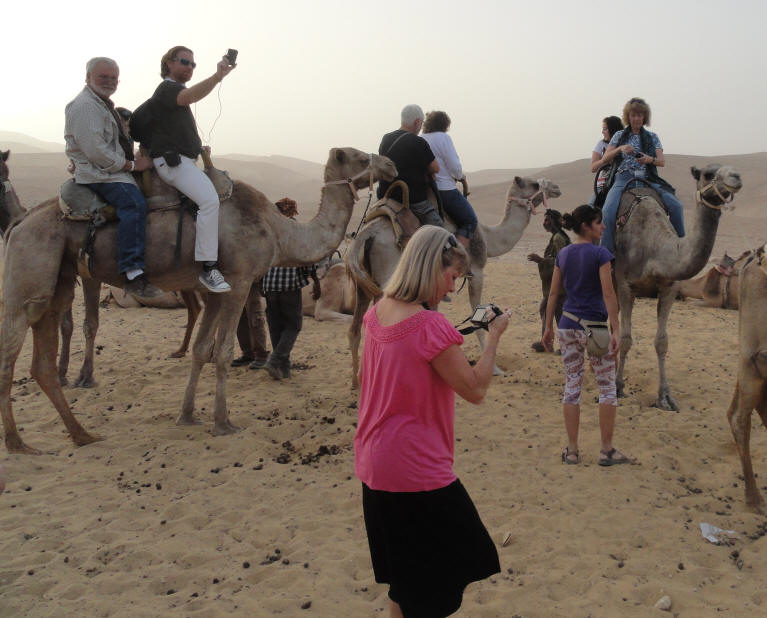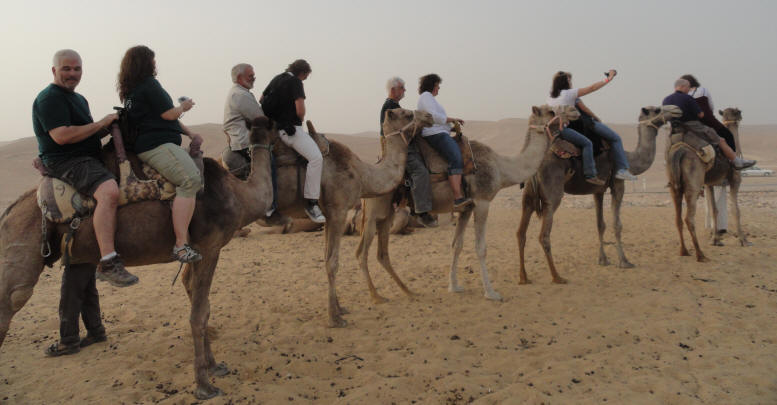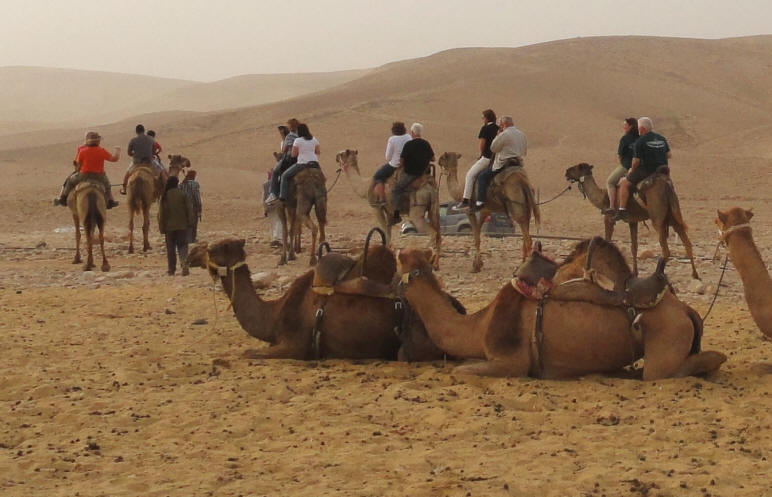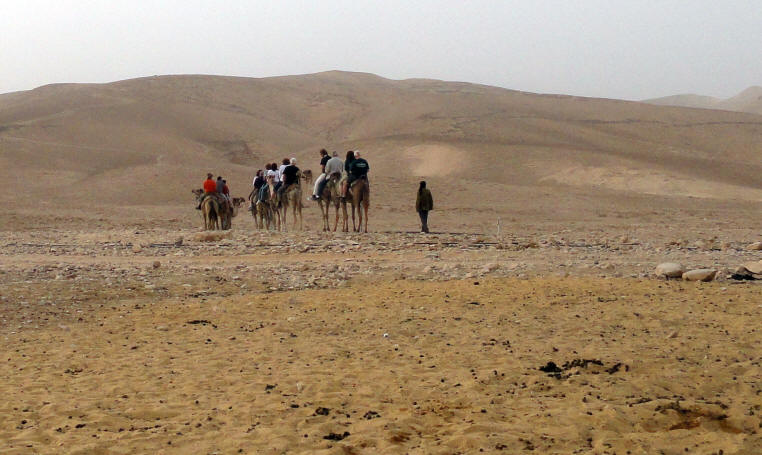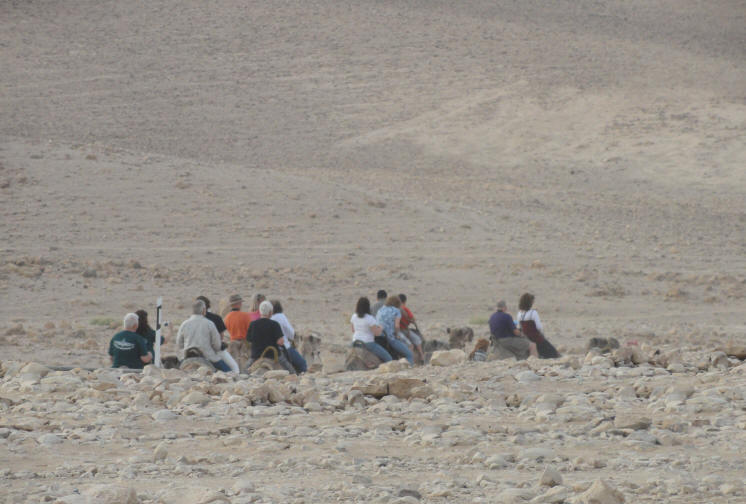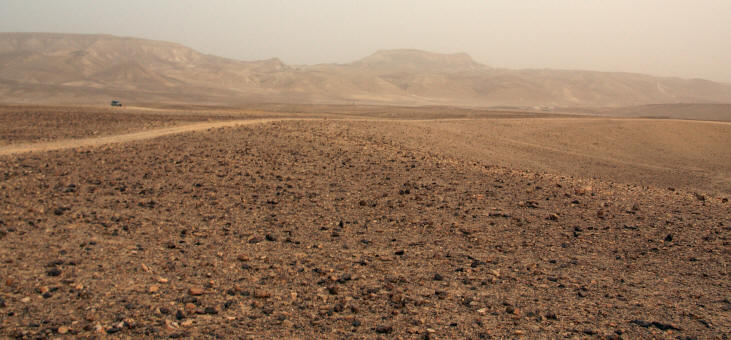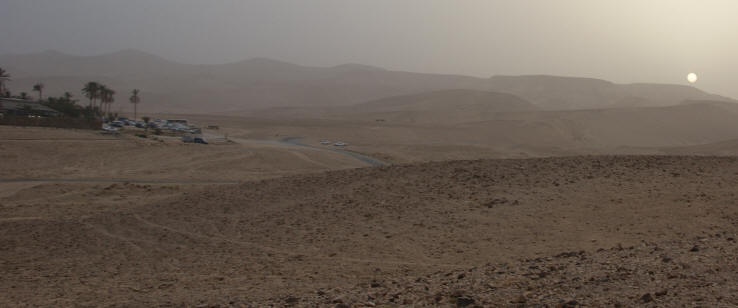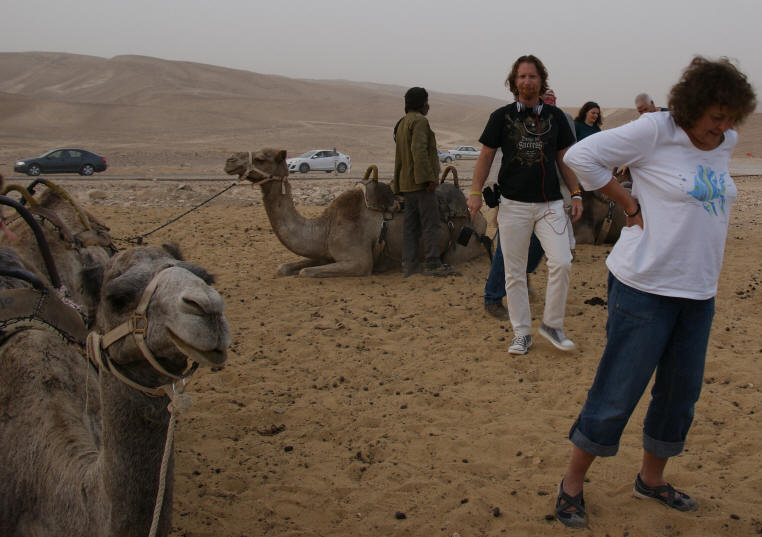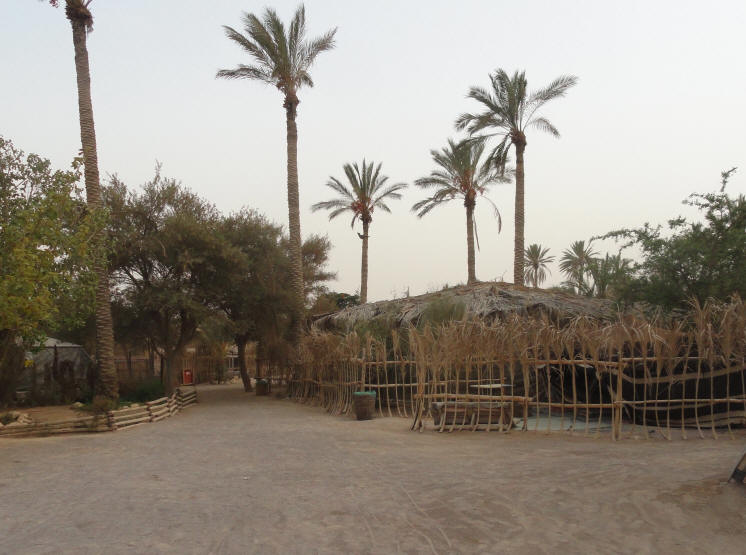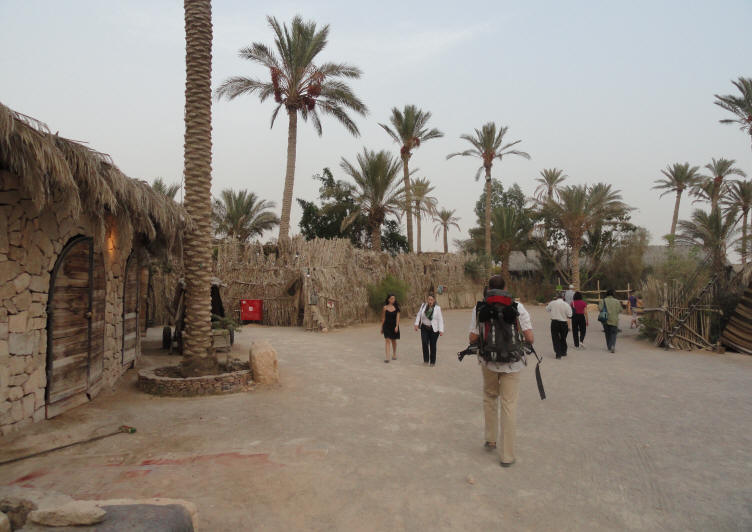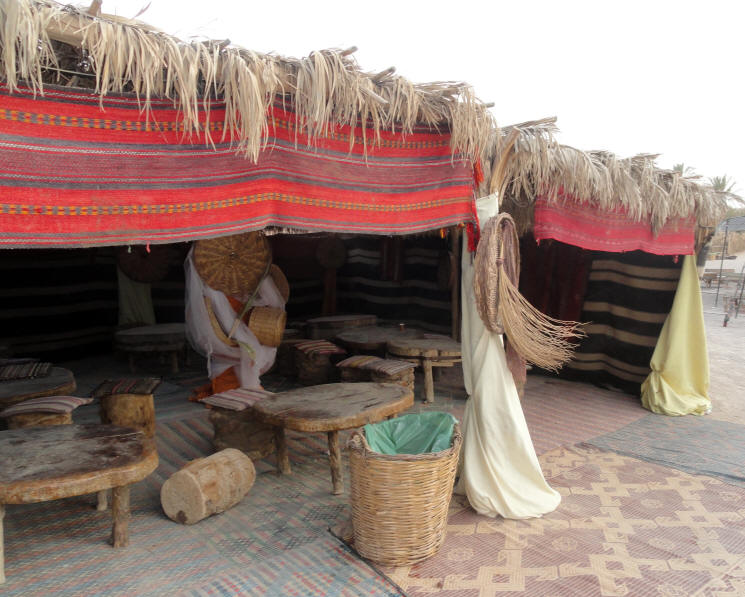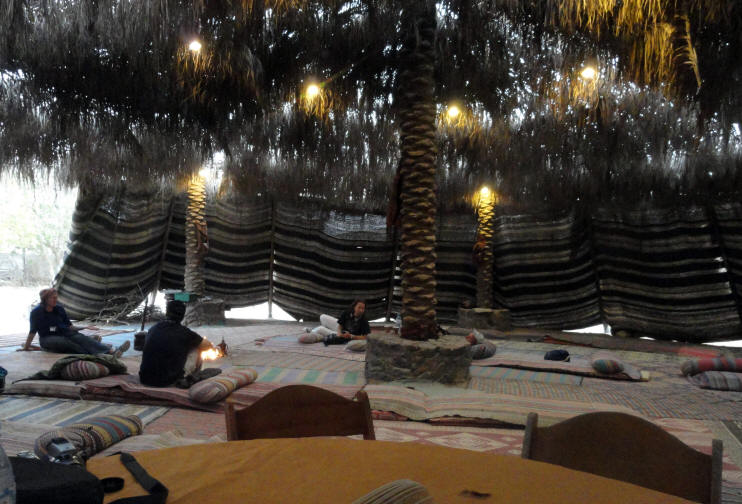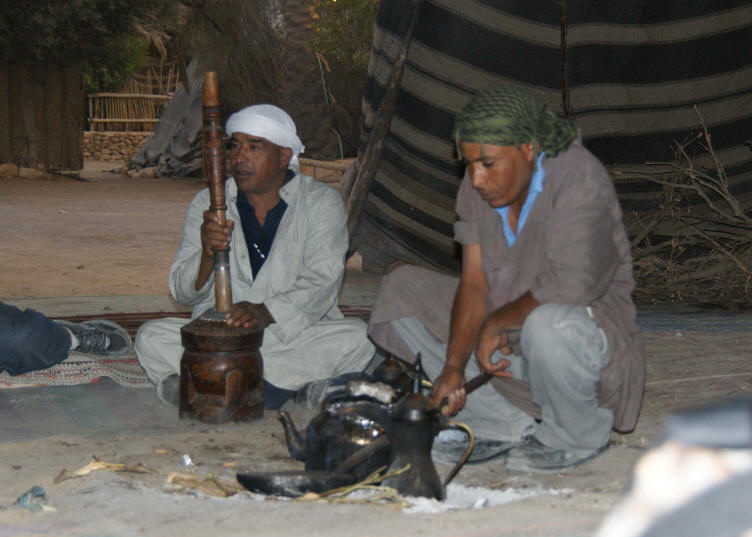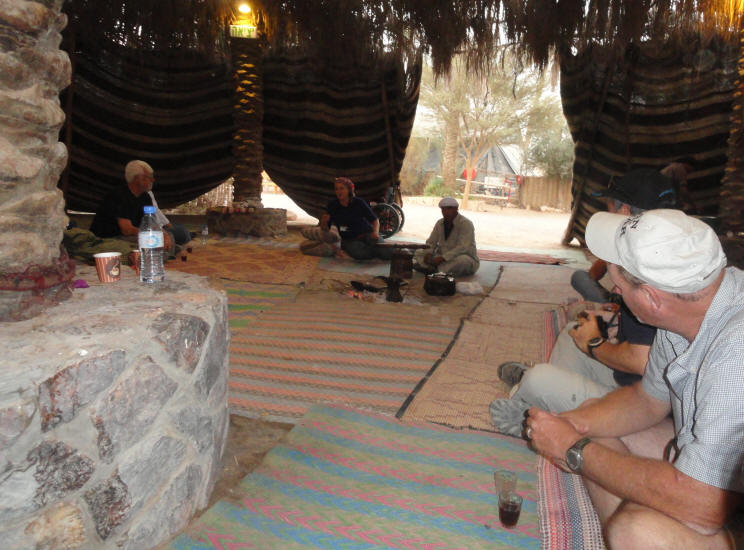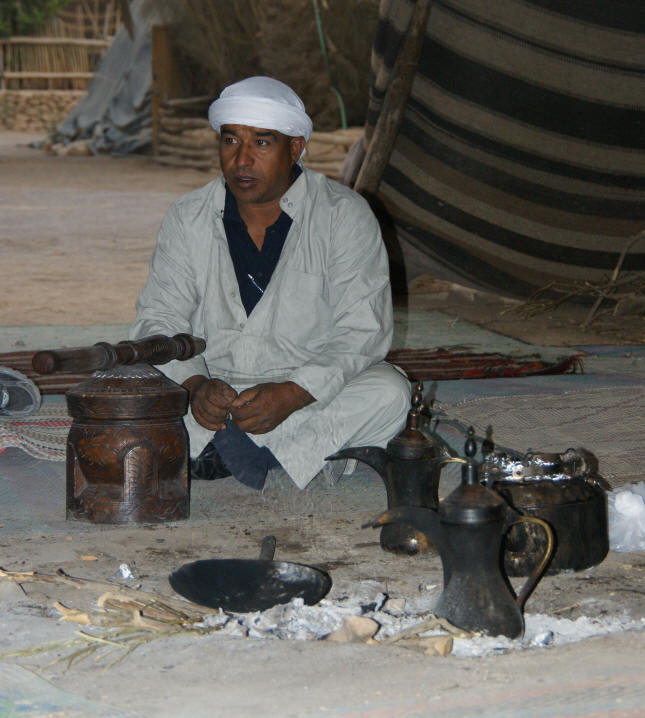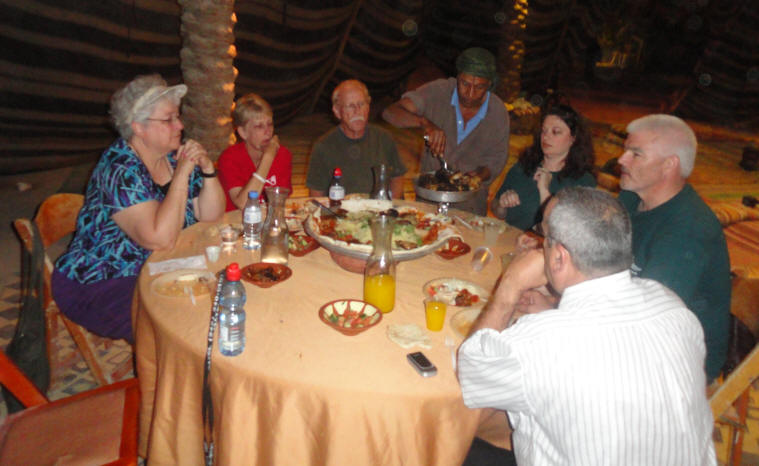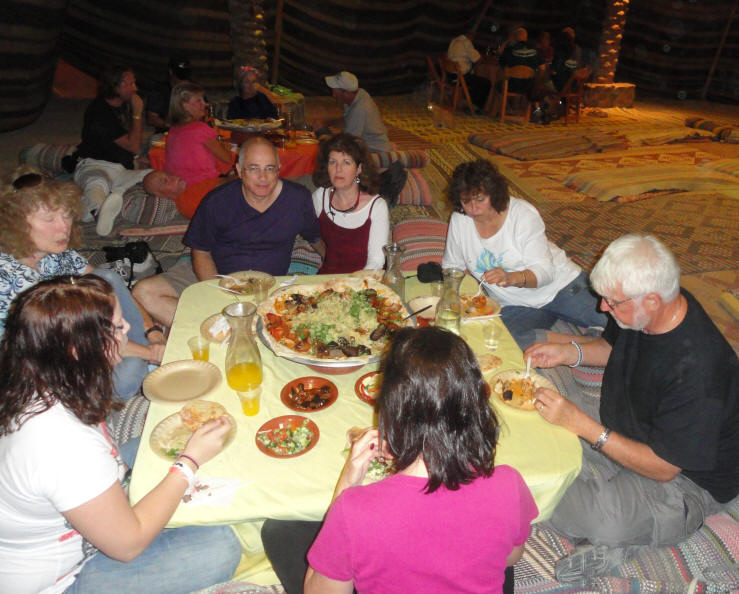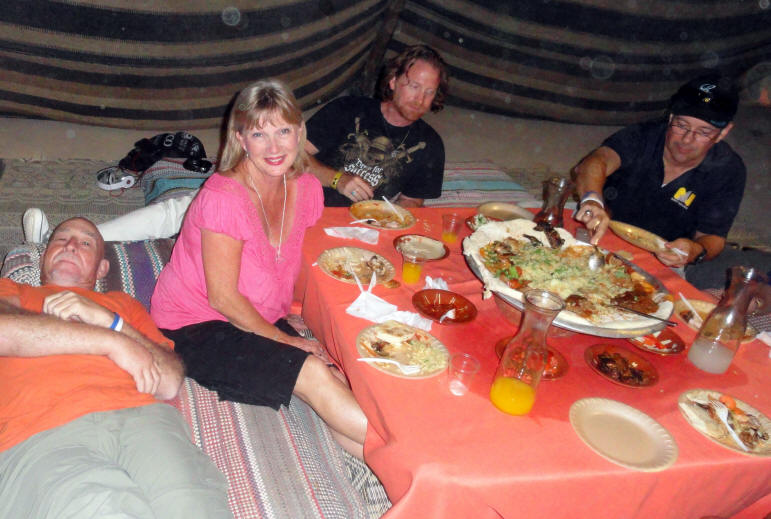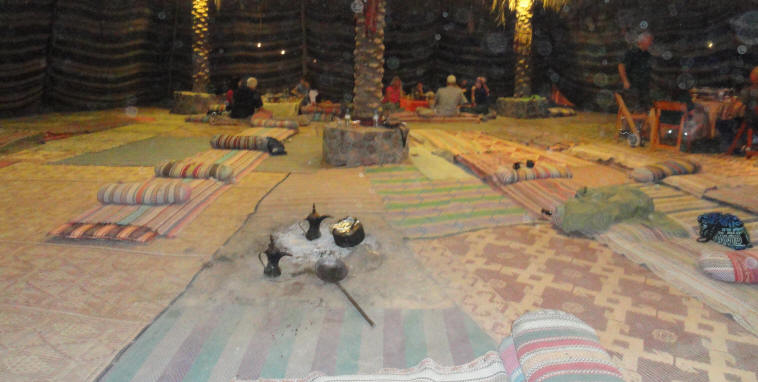Beit Yeshua
Israel Trip
21 October 2011
Day 10
Home
DAY 1
12 October 2011
DAY 2
13 October 2011
DAY 3
14 October 2011
DAY4
15 October 2011
DAY 5
16 October 2011
DAY 6
17 October 2011
DAY 7
18 October 2011
DAY 8
19 October 2011
DAY 9
20 October 2011
DAY 10
21 October 2011
Driving Through
the Desert
Qumran
Driving Through
the Desert
Ein Gedi
Dead Sea
Masada
Camel Ride
Bedouin Meal
DAY 11
22 October 2011
DAY 12
23 October 2011
Coming down the back side of Masadda
Isaiah 35: 1
The desert and the parched land will be glad; the wilderness will rejoice and blossom
Day 10
Friday, 21 October 2011, was our last day of touring with the group. We got up early, as usual, and were on the bus by 8:00 am headed for a day in the Israeli desert. Plans for the day included Qumran, Ein Gedi, the Dead Sea, Masada, a camel ride, and a Bedouin meal in the desert.
We had beautiful weather for the entire trip and the visibility, from what we were told, was the best we could have hoped for. On the last day, however, a dust storm came through Israel. Driving through the Judean Desert was a wonderful experience, but instead of the usual blue skies, we had gray dusty skies which limited the distance we could clearly see. An Arab camp with sheep grazing on the hillside
It looks like even a thirsty camel stopped at this service station for a "fill-up"
Our first stop for the day was Qumran. Qumran (Hebrew: קומראן) is an archaeological site in the West Bank. It is located on a dry plateau about a mile inland from the northwestern shore of the Dead Sea, near the Israeli settlement and kibbutz of Kalia. The Hellenistic period settlement was constructed around 134-104 BCE and was occupied most of the time until it was destroyed by the Romans in 68 CE or shortly after. It is best known as the settlement nearest to the caves in which the Dead Sea Scrolls were found. Entrance to the park
Since the discovery of the Dead Sea Scrolls in 1947, extensive excavations have taken place in Qumran. Nearly 900 scrolls were discovered. Most were written on parchment and some on papyrus. Cisterns, Jewish ritual baths, and cemeteries have been found in the area, along with a dining or assembly room and debris from an upper story believed to have been a scriptorium (or "place of writing"). Scholars believe the location to have been home to a Jewish sect, the Essenes.
The Communal House
The communal meal was a central event in the daily life of the Yahad Community. At midday, the Sectarians ceased work, bathed in the ritual bath, and gathered in the dining hall. An aura of sanctity enveloped the dining hall which also served as the meeting hall. Each member of the sect was served a modest portion of bread and cooked food. A priest conducted the meal and after he pronounced the blessings. The community ate in silence. The remains of a large long hall - probably a dining and meeting hall - were found at Qumran in a nearby pantry. Hundreds of pottery tableware pieces were discovered neatly arranged in piles.
Our tour guide, Pamela, tells us about the clay pots and bowls found at Qumran
Writing The Scrolls
About a dozen scrolls as well as myriad fragments of scrolls of all the books of the Bible (except the Book of Esther), Sectarian Texts and other Jewish literature of that period, were found in caves near Qumran. Texts were apparently written and copied in a scribes' room, which was on the second floor of a structure uncovered at the excavation. The scribes wrote with sharpened reed pens and ink on parchment sheets that were sewn together into scrolls. When a scroll was completed, it was rolled up and tied with leather straps.
The Scribes' Room and Writing Table
Moving outside, Pamela explains further about the ancient site
Qumran
Here were found the Dead Sea scrolls, some of the most important archeological discoveries in the world. They include Biblical and Apocryphal books, and Sectarian writings of the Second Temple Period. The first settlement at Qumran was a fortress inhabited in the 8 - 6 Centuries BCE. The inhabitants returned to their community until its destruction by the Romans in 68 CE. Some Jewish Warriors lived at Qumran during the Bar Kochba Revolt (132 - 135 CE), after which it was abandoned. The Second Temple Period inhabitants of Qumran are known as the Qumran Sect. A group of some 200 Jews who chose to settle here and lead a collective and ascetic life. This may be gleaned from remains discovered at the site, the most important of which are fragments of 900 different Second Temple Period scrolls found in 11 caves at Qumran. Some scholars assert that Qumran was a wayside inn, a Roman villa, a farmhouse, or a fortress.
Map of the Suggested Reconstruction of Qumran in the Second Temple Period
Ritual Bath
(Josephus Flavius)They labor with great diligence till the fifth hour, after which they assemble themselves into one place and when they have clothes themselves in white veils, they bathe their bodies in cold water. And after this purification is over, they meet together in an apartment of their own, while they go in a pure manner into the dining room, as into a certain holy temple.
Central Treasury
After he has entered the council of the community, he shall not have any share of the property of the congregation, and if it be his destiny to enter the company of the community, his property and earnings shall be handed over to the bursar of the congregation (Community Rule VI, 16-22).
These rooms belonged to the administrator responsible for finances and the community's spirit, the most important principle of which was collectivity. Three pottery jugs containing 560 silver coins were discovered in this room. This appears to have been the Central Treasury of the Sectarians.
Kiln
This kiln was used to fire the pottery utensils manufactured in the pottery workshop.
To see a "windy" video of the ruins at Qumran - CLICK HERE
Pottery Storeroom
The utensils found here were broken in the earthquake of 31 BCE
The Refectory
They Shall eat in common and bless in common and deliberate in common and when the table has been prepared for eating and the new wine for drinking, the priest shall be the first to stretch out his hand to bless the ... bread and new wine. Members of the sect assembled in this room for communal meals and doctrinal deliberations.
Cave 1
In 1947, three Bedouin shepherds discovered eight clay jars in this cave. One jar contained three scrolls: the complete Isaiah scroll (written in popular version), the Community Rule (the Rule Book of the Qumran Sect), and the Habakkuk Commentary (an interpretation of the Book of Habakkuk in light of the events of the Second Temple Period.
Later, four additional scrolls were discovered in the cave: a second version of the Book of Isaiah written in the Masoretic style, The War Scroll which describes a war to be followed by Judgment Day, the Thanksgiving Scroll containing forth Psalms of Thanksgiving, and the Genesis Apocryphon written in Aramaic in a Narrative style and expanding on the Genesis stories.
The Scrolls Cave
Bedouins discovered this cave in August of 1952. Fourteen thousand fragments of scrolls were unearthed as they sifted through the dust within. Archaeologists who reached the cave later uncovered an additional 1000 fragments. Scholars believe that a Roman soldier who entered the cave in 68 CE tore the scrolls intentionally and that later ravages by animals and climate inflicted further damage. As research proceeded, the fragments of these scrolls were pieced together to produce 530 different scrolls. Publication of these scrolls was completed in 2001.
Cave 4
To see the video of Cave 4 at Qumran where part of the Dead Sea Scrolls were found
and a first look at the Dead Sea from Qumran - CLICK HEREThe group stops under a tent as Pamela further explains about Cave # 4 As the tour of Qumran concludes, everyone does a little shopping in the gift shop
Leaving Qumran, we headed toward Ein Gedi. The bus passes through an Israeli check-point First look at the Dead Sea
Ein Gedi (Hebrew: עֵין גֶּדִי) is an oasis in the Israeli desert, located west of the Dead Sea, near Masada and the caves of Qumran. The name Ein-Gedi is composed of two Hebrew words: "ein" means "spring" and "gdi" mean "goat-kid", thus meaning "Kid Spring".
The dust storm continues as we approach Ein Gedi In the 2 Chronicles 20:2 it is identified with Hazazon-tamar, where the Moabites and Ammonites gathered in order to fight Jehosaphat. In Genesis 14:7 Hazazon-tamar is mentioned as being a Amorite city, smitten by Chedorlaomer in his war against the cities of the plain.
In Joshua 15:62, Ein Gedi is enumerated among the cities of the Tribe of Judah in the desert Betharaba, but Ezekiel 47:10 shows that it was also a fisherman's town. Later, King David hides in the desert of Ein Gedi (1 Samuel 24:1-2) and King Saul seeks him "even upon the most craggy rocks, which are accessible only to wild goats".
Entrance to the Ein Gedi Nature Reserve The indigenous Jewish town of Ein Gedi was an important source of balsam for the Greco-Roman world until its destruction by Byzantine emperor Justinian as part of his persecution of the Jews in his realm. A synagogue mosaic remains from Ein Gedi's heyday, including a Judeo-Aramaic inscription warning inhabitants against "revealing the town's secret" – possibly the methods for extraction and preparation of the much-prized balsam resin.
To see the video at Ein Gedi - CLICK HERE Ein Gedi nature reserve was declared in 1971 and is one of the most important reserves in Israel. The park is situated on the eastern border of the Judean Desert, on the Dead Sea coast, and covers an area of 14,000 dunams (defined as "forty standard paces in length and breadth). The elevation of the land ranges from the level of the Dead Sea at 423 meters (1,388 ft) below sea level to the plateau of the Judean Desert at 200 meters above sea level. Ein Gedi nature reserve includes two spring-fed streams with flowing water year-round.
King David Falls To see the Ein Gedi Waterfall Video - CLICK HERE Mammal species in Ein Gedi include the ibex and the hyrax. We were pleased to see the Ibex in Ein Gedi ... To see the video of the Ibex at Ein Gedi - CLICK HERE The words "rabbit", "hare" or "coney" appear as terms for the "hyrax" in some English translations of the Bible. Early English translators had no knowledge of the hyrax (Hebrew שָּׁפָן shaphan), and therefore no name for them. There are references to hyraxes in the Old Testament, particularly in Leviticus 11, where they are described as lacking a split hoof and therefore being not kosher. It also claims that the hyrax chews its cud, however, this claim is due to the habit of the hyrax chewing without having ingested anything, resembling the chewing of cud. Some of the modern translations refer to them as rock badgers.
... and the hyrant We filled up our water bottles with spring water and board the bus to leave Ein Gedi
The Dead Sea (Hebrew: יָם הַמֶּלַח, Yām Ha-Melaḥ, "Sea of Salt"), also called the Salt Sea, is a salt lake bordering Jordan to the east and Israel and the West Bank to the west. Its surface and shores are 423 metres (1,388 ft) below sea level, the lowest elevation on the Earth's surface. The Dead Sea is 377 m (1,237 ft) deep, the deepest hypersaline lake in the world. With 33.7% salinity, it is also one of the world's saltiest bodies of water.
The Dead Sea has attracted visitors from around the Mediterranean basin for thousands of years. Biblically, it was a place of refuge for King David. It was one of the world's first health resorts (for Herod the Great), and it has been the supplier of a wide variety of products, from balms for Egyptian mummification to potash for fertilizers. People also use the salt and the minerals from the Dead Sea to create cosmetics and herbal sachets. In 2009, 1.2 million foreign tourists visited on the Israeli side.
The Jordan River is the only major water source flowing into the Dead Sea, although there are small perennial springs under and around the Dead Sea, creating pools and quicksand pits along the edges. There are no outlet streams.
The bus dropped us off at a restaurant at near the Dead Sea & everyone enjoyed a salad for lunch
After lunch, everyone headed down to the Dead Sea
Umbrellas for visitor usage at the Dead Sea
The place was packed with visitors who were eager to enjoy the mineral-rich waters
Because of the dust storm & the wind, the water of the Dead Sea was choppy with strong waves
To see the video of Jim & Linda in the Dead Sea - CLICK HERE
Also: Janice, Chuck, Gid & Duke get in the waterJanice, Duke, Chuck and Gid struggle with the waves but eventually get in the water
To see the video of Janice, Chuck, Gid and Duke float in the Dead Sea - CLICK HERE Janice struggles with the waves and undertow

It's impossible to sink because of the salinity of the water - you naturally float
Gloria and Brittany join the others
A steep climb back to the top of the hill
Some of the group chats while the others change out of their wet clothes
Masada (Hebrew מצדה, from מצודה, metzuda, "fortress") is the name for a site of ancient palaces and fortifications in the South District of Israel, on top of an isolated rock plateau, on the eastern edge of the Judean Desert, overlooking the Dead Sea. Masada is best known for the violence that occurred there in the first century CE. In the final accords of the First Jewish-Roman War, a Siege of Masada by troops of the Roman Empire led to the mass suicide of the Sicarii rebels.
The cliffs on the east edge of Masada are about 1,300 feet (400 m) high and the cliffs on the west are about 300 feet (91 m) high; the natural approaches to the cliff top are very difficult. The top of the plateau is flat and rhomboid-shaped (rhombus-shaped), about 1,800 feet (550 m) by 900 feet (270 m). There was a casemate wall around the top of the plateau totaling 4,300 feet (1.3 km) long and 12 feet (3.7 m), with many towers, and the fortress included storehouses, barracks, an armory, the palace, and cisterns that were refilled by rainwater. Three narrow, winding paths led from below up to fortified gates.
According to Josephus, a 1st-century CE Jewish historian, Herod the Great fortified Masada between 37 and 31 BCE as a refuge for himself in the event of a revolt. In 66 CE, at the beginning of the First Jewish-Roman War against the Roman Empire, a group of Jewish extremists, called the Sicarii, overcame the Roman garrison of Masada. After the destruction of the Second Temple in 70 CE, additional members of the Sicarii and numerous Jewish families fled Jerusalem and settled on the mountaintop, using it as a base for standing against the Romans.
In 72, the Roman governor of Iudaea Lucius Flavius Silva headed the Roman legion and laid siege to Masada. The Roman legion surrounded Masada and built a circumvallation wall and then a siege embankment against the western face of the plateau, moving thousands of tons of stones and beaten earth to do so.
The rampart was complete in the spring of 73, after probably two to three months of siege, allowing the Romans to finally breach the wall of the fortress with a battering ram on April 16. According to Josephus, when Roman troops entered the fortress, they discovered that its 960 inhabitants had set all the buildings but the food storerooms ablaze and committed a mass suicide.
While a hike up the Snake Path on the eastern side of the mountain (access via the Dead Sea Highway) is considered part of the "Masada experience," a cable car operates at the site for those who wish to avoid the physical exertion. Due to the remoteness from human habitation and its arid environment, the site has remained largely untouched by humans or nature during the past two millennia. The Roman ramp still stands on the western side and can be climbed on foot. Many of the ancient buildings have been restored from their remains, as have the wall-paintings of Herod's two main palaces, and the Roman-style bathhouses that he built. The synagogue, storehouses, and houses of the Jewish rebels have also been identified and restored. The meter-high circumvallation wall that the Romans built around Masada can be seen, together with eleven barracks for the Roman soldiers just outside this wall. Water cisterns two-thirds of the way up the cliff drain the nearby wadis by an elaborate system of channels, which explains how the rebels managed to have enough water for such a long time.
The dust storm makes visibility difficult Our first views of Masada Entrance to the site as seen from the bus as we approach Masada We get off the bus, walk into the Visitor's Center at the Eastern Entrance
where Pamela gets our tickets for the cable car ride to the top of the mountainThe exhibit at the Eastern Entrance Visitor's Center To see the video we saw before we went to the top of Masada - CLICK HERE To see a large Map of Masada - CLICK HERE Ticket in hand, we all follow Pamela to the cable cars The cable car delivers us all safely to the top of the mountain ... ... and we take a look back down the mountain from where we came Leaving the cable car area and heading into Masada via the Snake Path Gate 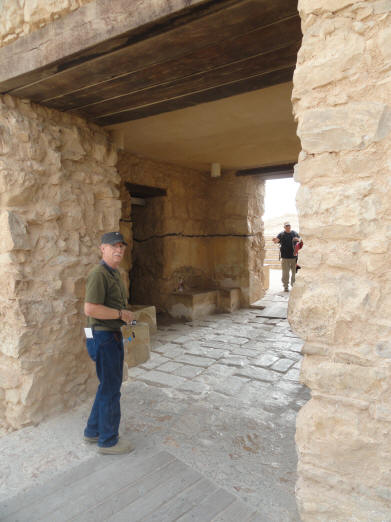
The Watch Tower
On the southern portion of the administration building, you can ascend the watch tower for an extensive view of the plateau and its surroundings. In Herod's day, the tower served as a guard's lookout. South of the tower are the "officers' quarters", a residential house built in barracks style in Herod's day to house his soldiers. The Watch Tower
The Western Palace
At 3, 700 square meters, the Western Palace, built during Herod's reign, is the largest structure on Masada. It was built around a core that consisted of an open courtyard containing living quarters, guard rooms, reception rooms and a series of bathing rooms. To the right of the entrance is a model of the reconstructed palace. As you enter the palace, you will see benches covered with stucco reliefs. Crossing the long narrow courtyard, notice the water channel on its eastern side. You will pass through two vestibules with benches leading to a central well-plastered courtyard. In this courtyard you will see a model of the core of the grand palace. In this part of the palace is a room identified as a throne room because of four depressions discovered in the floor where a throne may have been placed. Ascend the flight of steps on the north side of the courtyard to view the bath complex below, with its mosaics and stucco. Nearly is a reception room with a magnificent colorful mosaic. Going down the steps, you will see a room on the left containing two bathtubs and a water cistern. Now head toward the public immersion pool. The Western Palace The Western Palace Triclinium or Dining Room from 30 BCE to 70 CE Moving into the large courtyard The group examines a model showing the core of the grand palace One of the internal rooms of the grand palace Heading upstairs to the 2nd floor level of the Western Palace Looking down on the bath complex with its mosaics and stucco-covered walls 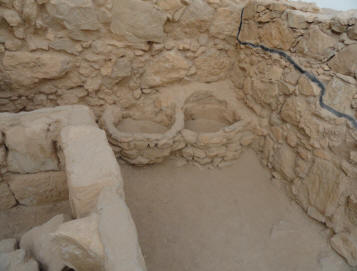
Steps leading down from the bath complex
Notice what appears to be a drainage hole in the lower part of the tub
The Byzantine Church
The Byzantine empire existed for more than a thousand years, from the 4th century under Emperor Constantine to 1453. During most of its existence, it remained one of the most powerful economic, cultural and military forces in Europe. "Near the Dead Sea is a mountain called Marda (Masada). On this mountain live hermits, who have a vegetable garden six miles away, near the seashore ... Whenever the hermits wish to send out to the garden for vegetables, they harness a donkey and tell it 'Go to the garden and bring us vegetables...' And it goes down quite alone to the gardener. Every day one can see the donkey ascending and descending on its own and serving the elders" John Moschus, 600 CE Why did monks settle in the ruins of a fortress in the heart of the desert? In the desert they sought the tranquility that would bring them closer to the Creator. The cells of the monks who lived on Masada in the 5th to 7th Centuries CE were scattered all over the mountain in small building, in caves and in cisterns that had gone out of use. There they communicated with the Creator in isolation, and here, in the church, they gathered to worship together. The floor of the church were decorated with mosaics. The courtyard of the church, in which some domestic installations were found, was walled. Water was brought here from the cisterns on the slopes and from renovated cisterns on the summit. The group heads toward the remains of a Byzantine Church Entering the Byzantine Church
The Byzantine Church
The center of the Byzantine monastery was the church, which is well preserved. Pass through the narthex (or lobby), with its white mosaic, and continue to the nave (the central part of the church). The floor here was originally paved with mosaic and its walls were decorated with a design created from pottery shards inserted in plaster. The room's semicircular shape is preserved to its original height; glass from its window was found in the church courtyard. The floor contains a pit, which may have served as a crypt or a reliquary. It was dug in the ground beneath the altar, which was originally sectioned off by a decorated marble chancel. The church was roofed with clay tiles, which were found by the dozens during excavation. Plastered stone gutters protruded from the roof of the church and were attached to its outer walls. The western room of the church contains a mosaic depicting floral designs and medallions encircling fruit and baskets of communion bread. A low stone wall surrounded the church courtyard, where a number of farming installations were discovered.
(Left) Walls were decorated with pottery shards inserted into plaster
(Right) The semicircular nave of the Byzantine Church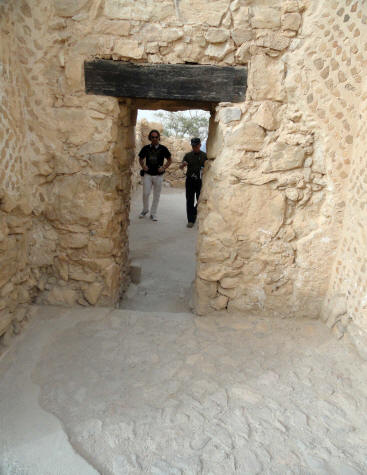
Mosaic floor in the Byzantine church is long with elaborate frescos on the walls
and with Geometric designs on the walls
Barracks & Rebel Dwellings
This large group of modest structures hugging the inner face of the perimeter wall served as living quarters during the Great Revolt. Artifacts discovered here reveal elements of daily life during the period of the revolt. Among them were textiles, tools and plaited baskets, as well as pottery and glass vessels and bone utensils. Leather items were also discovered, together with stone and metal implements and coins. Jewelry and even foodstuffs were also found. However the most outstand discoveries were written finds in Hebrew and Aramaic, which provide a rare glimpse of community life. Barracks & Rebel Dwellings To see the video of the Rebel Barracks as well as the Watch Tower - CLICK HERE
Water Cistern
The water cistern drains the northern half of the plateau, and the makeup of its plaster hints that it may have been constructed as early as Hasmonean times. A plastered channel originating at the Snake Path Gate led water to this cistern. The cistern was renovated and reused by the Byzantines. Cistern
The Synagogue
"Long since, my brave men, we determined neither to serve the Romans nor any other save God..." Josephus Flavius The rebel's way of life on Masada required a building suitable for community meetings and Torah readings. This building, which became a synagogue during the revolt, was built in Herod's time, most likely as a stable. The rebels changed its internal structure at the time of the Great Rvolt, when rows of benches lining the hall and even closed off a small room in the corner of the hall, which apparently served for storage of Torah scrolls and as a genizah (repository for damaged scrolls). Under its floor were found fragments of Biblical scrolls, including the "Vision of the Dry Bones" in the Book of Ezekiel. On the floor of the room an inscription was found that read "the priest's tithe". The synagogue at Masada is one of the very few discovered so far that date from the Second Temple period.
The Synagogue
The "Casement of the Scrolls"
A large and rare concentration of finds from the time of the revolt was found in a corner of the room of the wall in which we stand: inscribed sheets of papyrus, fragments of scrolls, silver shekel coins, textiles, sandals and glass vessels and bone implements. Among the finds were the pay record of a Roman cavalryman in the Tenth Legion. The most interesting finds were the scroll fragments, some of which show that during the siege there were members of different sects on the mountain. The finds were gathered here by Roman soldiers collecting booty after the fall of Masada. On the floor of the room were found ballista balls and rolling stones, which came from the roof of the casemate and the nearby tower.
Casement of the Scrolls 
Columbarium Towers
Why did the King raise doves on the mountain? There were three columbarium towers on Masada. The one in front of us was used as a dovecot in its ground floor and as a watchtower in its upper story. In the walls of the dovecot are several hundred niches in which the doves roosted. They supplied meat for Masada's inhabitants and guests and probably also fertilizer for agricultural crops.
Columbarium Towers
Breaching Point
Here the siege of Masada ended. The ramp that the Romans had built up to the summit of the mountain reached to below this point. At the top of the ramp rose the siege tower, and in it was the battering ram with which the Romans assaulted the casemate wall. However, the rebels had built a wall of earth and wood, against which the battering ram was ineffective: "Observing this, Silva, thinking it easier to destroy this wall by fire, ordered his soldiers to hurl at it showers of burning torches... At the first outbreak of the fire, a north wind which blew in the faces of the Romans caused them alarm; far diverting the flame from above, it drove it against them... Then suddenly the wind veering, as if by divine providence, to the south and blowing will full force in the opposite direction, wafted and flung the flames against the wall, which now through and through was all ablaze." Josephus Flavius When night fell, and it was clear that the situation was hopeless and that the Romans would break in at dawn, Eleazar Ben Ya'ir assembles his followers and called for mass suicide: "The Romans, expecting further opposition... were at a loss to conjecture what had happened... Here encountering the mass of the slain, instead of exulting as over enemies, they admired the nobility of their resolve and the contempt of death displayed by so many in carrying it, unwavering, into execution." Josephus Flavius The excavations here uncovered ballista balls and arrowheads, numerous slingshots and signs of burning, evidence of the battle that raged at this spot.
Breaching Point
The massive dirt ramp built by the Romans us the back side of Masada to reach the top[From the bottom look upward toward Masada]
Byzantine Western Gate
This gate of dressed stones stood at the upper end of the path that led over the ramp to the top of the mountain during the Byzantine era. It serves as an entrance (or exit) to this day. Even though we had ridden up on the cable car, the decision was made to exit Masada by the Western Gate and hike down the back side of the mountain so that we could make it on time to our camel ride and Bedouin dinner meal. Eytan (our bus driver) had dropped us off at the Eastern Entrance and had left immediately to pick us up at the Western Entrance - a drive around the mountain that was at least an hour and a half. The group starts the arduous trek down the back side of the mountain Everyone exits through the Byzantine Western Gate To see the video of us starting down the back side of Masada - CLICK HERE To see the video of us walking down the back side of Masada - Part 2 - CLICK HERE The long walk down the back side of the mountain was one of my favorite parts of the experience The hike down included numerous steps on the dirt path
- that were pretty demanding on aging kneesIs Paul posing for a photo or simply taking a break? The dirt ramp built by the Romans to breach Masada
The Northern Palace
This grand and daring building constructed by Herod is Masada's architectural gem. It is 30 meters high, built on three rock terraces and supported by impressive retaining walls. Combining both Hellenistic and Roman architectural elements, the palace was built to host high-ranking visitors and to all the king his solitude. Herod and his family lived on the upper level, and the two lower levels were for receptions. The upper terrace, consisting of the king's private rooms and a lookout patio, has been preserved in its original Herodian form. From the semicircular terrace, which was once surrounded by columns, the remains of the Roman siege system and the ancient road northward can clearly be seen. In addition to the strategic advantage of the palace's location at the inaccessible northern edge of the cliff, residents could enjoy the breeze at this point. From here you can look down on the two lower levels of the palace. Descent to these levels in antiquity was via a flight of stairs west of the palace that was destroyed in an earthquake. The residential wing consisted of four rooms and a central roofed hall. Its rooms were paved with mosaics containing geometric patterns, and their walls were covered with frescoes. A model depicting the restored Northern Palace can be seen in the central hall. A black and white mosaic has been preserved in the southwestern room. A similar mosaic design can be seen in the courtyard of the large bathhouse. Parallels of this style have been found in Italy, which indicates that Herod brought the mosaic masters, like his fresco artists, from Italy. In the center of the middle terrace level of the palace was a circular hall for banquets and receptions, surrounded by columns of which only the foundations remain. The steps leading to the lower terrace of the palace are original. This level, which was also used for banquets and receptions, consisted of a chamber surrounded by columns. Pilasters, once painted and topped by Corinthian capitals, stand against the southern wall. The outer walls of this central hall were plastered and covered with stucco, and the inner walls were covered with frescos depicting imitation marble slabs and geometric paterns. East of the hall a flight of stairs descends toward a small bathhouse including a tepid room, a cold room, and a hot room. Finds here seemingly attest to the events of Masada's last night - the skeletal remains of three individuals identified with the rebels, vestiges of clothing and sandals, arrows, and numerous pieces of mail armor. Among the most chilling finds was a woman's braided hair, remarkably preserved. Because of our limited time on the top of the mountain, we were unfortunately not able to explore the Northern Palace. From a lookout on the way down, we could get a distant view of the Northern Hanging Palace
near the northern top side of the mountainA view of all three terrace levels of the Northern Palace of King Herod Once we got to the bottom of the massive hill, we had to climb another smaller one Once at the bottom of the mountain, we take a look back toward the top To see the video of us looking back up the mountain from the bottom - CLICK HERE Duke captured these wonderful panoramas at Masada As we finally reached the base of the mountain,
we had to check out the replicas of large Roman weapons on display thereA Roman Siege Engine A Roman Catapult Everyone boards the bus and we're off to our camel ride and Bedouin meal Masada was definitely one of my favorite parts of the 2011 trip to Israel Camel Ride Through The Desert
Once on the bus, everyone was able to relax a little as we continued our drive through the Judean Desert on our way to our camel ride and Bedouin meal. As we continued our drive through the Judean Desert
we passed several Bedouin men riding on donkeysWe had to drink lots of water to stay hydrated - not only in the desert - but during the entire trip
The Bedouin Village (right) with white tents set up (on the left) for a wedding
As we got off the bus, everyone was really excited to see the camels we'd be riding
Jim and Linda were the first to board their camel ... followed by Curtis and Gid ... ... Doug & Lynda then Brittany & Gloria were the next the mount their camels ... ... then Duke & Myrl ... ... and finally Chuck & Janice You might not believe it, but this was the "first" time any of us had ever been on a camel How can you tell? Because we all "wanted" to ride the camel! To see the video of us riding the camels - CLICK HERE And off we go Visibility for those watching us from the village gets fuzzier as we ride further and further away We had a beautiful view of the desert during our 45 minute camel ride The sun begins to set as we head back toward the Bedouin village The ride turned out to be "a little more uncomfortable" than any of us had expected
[Gid's facial expression says it all - we all had a good laugh]
The Bedouin are a part of a predominantly desert-dwelling Arab ethnic group traditionally divided into tribes or clans. The term "Bedouin" comes from an Arabic word that means "those who live in the desert". Starting in the late 19th century, many Bedouin under British rule began to transition to a semi-nomadic lifestyle. In the 1950 and 1960s, large numbers of Bedouin throughout the Middle East started to leave the traditional, nomadic life to settle in the cities of the Middle East, especially as population levels have grown. Government policies in Egypt, Syria and Israel, oil production in the Persian Gulf, as well as a desire for improved standards of living, effectively led most Bedouin to become settled citizens of various nations, rather than stateless nomadic desert herders throughout Islam.
The group enters the Bedouin village in preparation for the evening meal A large tent was set aside where we would experience a wonderful Bedouin meal Many of us sat on the matted dirt floor as we met our Bedouin host Pamela sat with our Bedouin host and translated
as he explained the Bedouin coffee/tea ceremony involving 3 cups of coffeeTo see the video of the Coffee Ceremony - CLICK HERE Coffee beans were roasted over a fire and ground to make the fresh coffee Exactly three sips of coffee were in each cup
If you're given a full cup of coffee it means you've insulted your host and are expected to leaveOur Bedouin host explained Bedouin life
and told us about his three wives and that he was looking for wife number fourThe Bedouin mean started with fresh vegetables, wonderful pita bread,
humus, cabbage slaw, salsa, orange juice and lemonadeAn extravagant meal was prepared and placed on each table that included
rice, onions, several types of cooked meat - including chicken, beef and lamb,
and many types of candied fruitsAs the large dish of food started to empty, it was refilled Most of the group sat or reclined at low tables Looking into the tent where we ate At the end of the evening, we all boarded the bus and left the Judean Desert
heading back to Jerusalem and the Prima Kings Hotel
More Photos and Information From the 2011 Sukkot Trip
Day 2 - 13 Oct 2011 Day 3 - 14 Oct 2011 Day 4 - 15 Oct 2011 Day 5 - 16 Oct 2011 Day 6 - 17 Oct 2011 Day 7 - 18 Oct 2011 Day 8 - 19 Oct 2011 Day 9 - 20 Oct 2011 Day 10 - 21 Oct 2011 Day 11 - 22 Oct 2011 Day 12 - 23 Oct 2011





